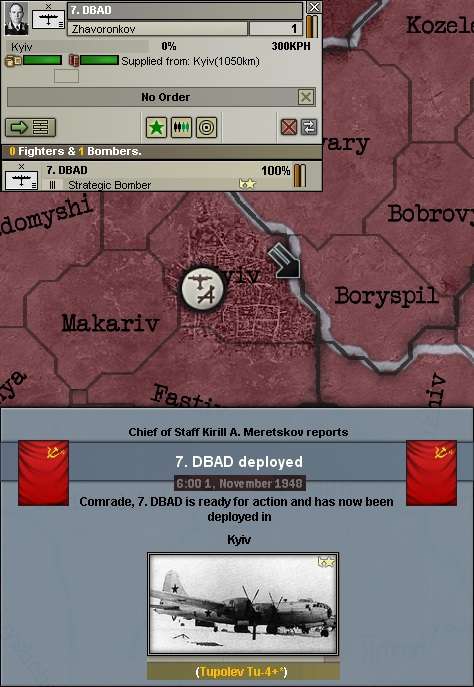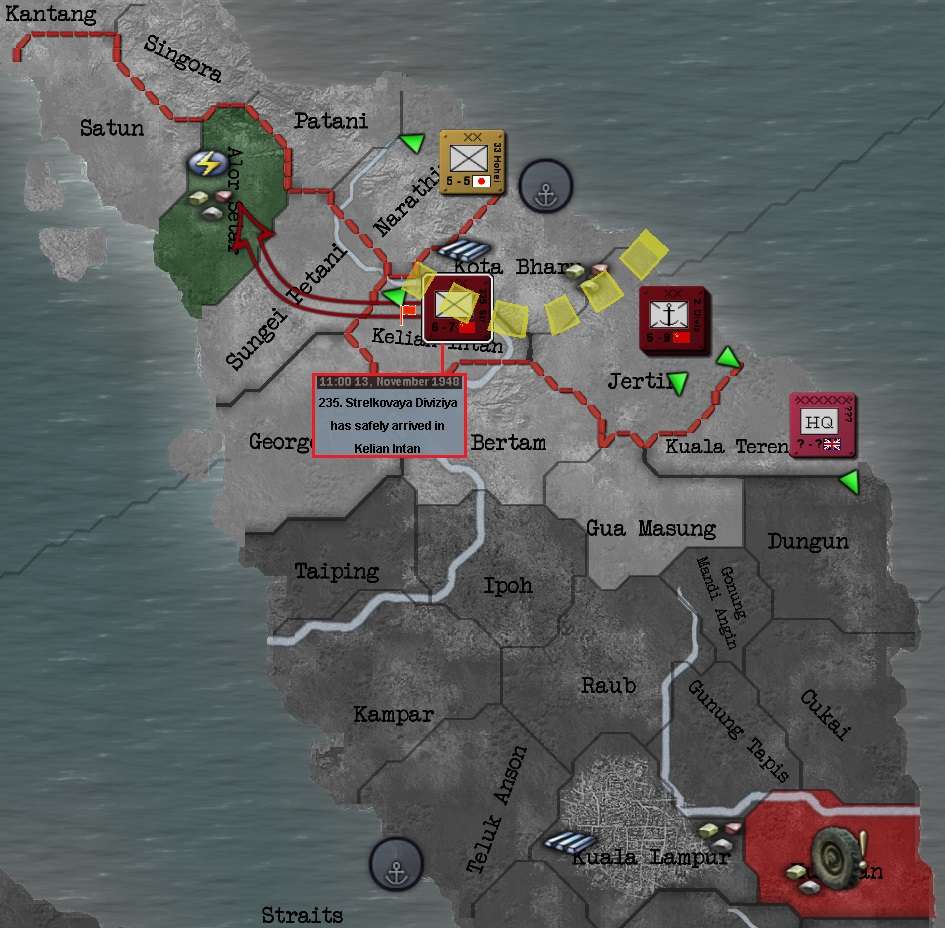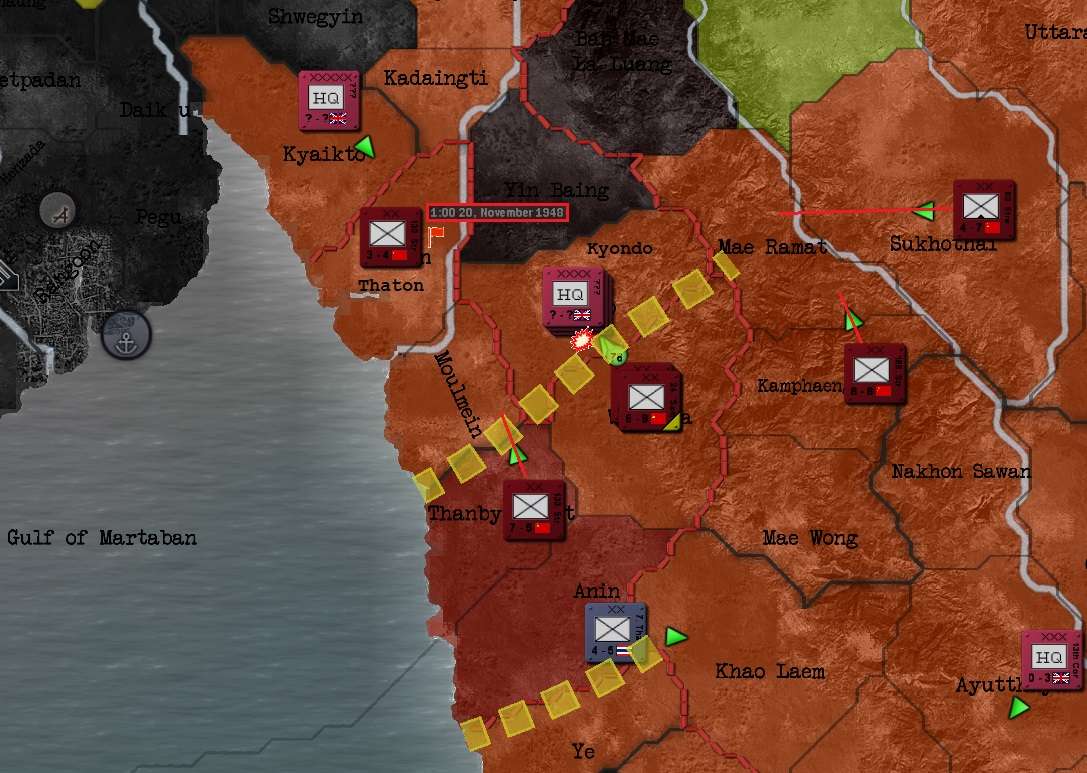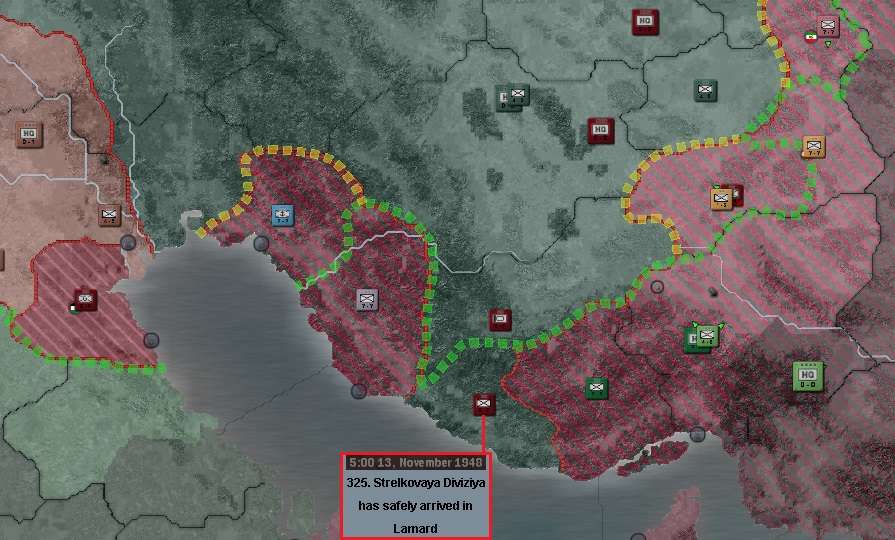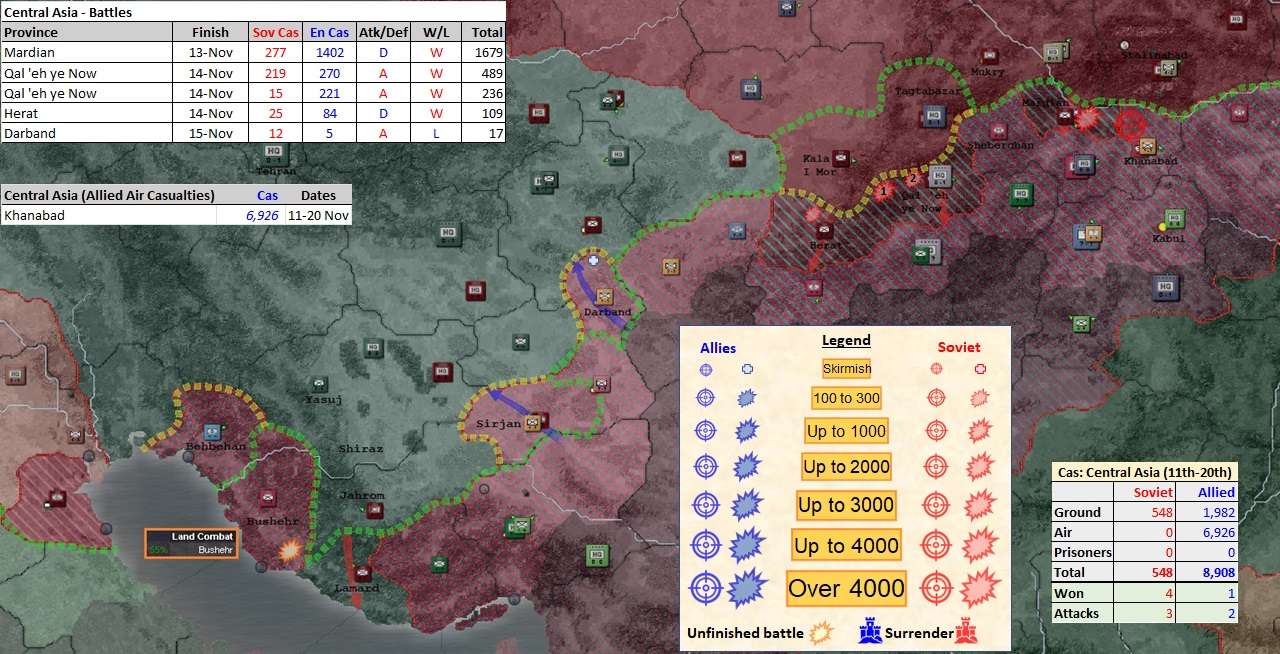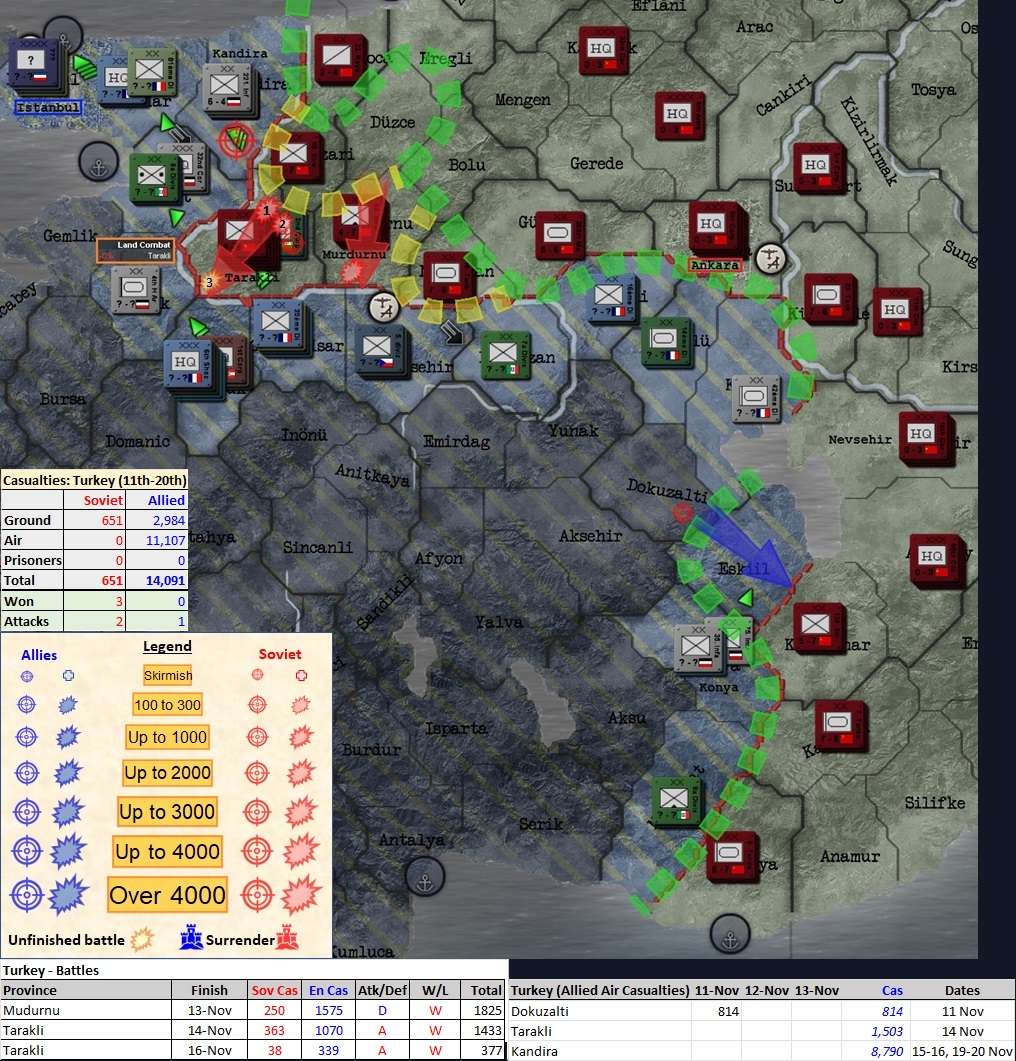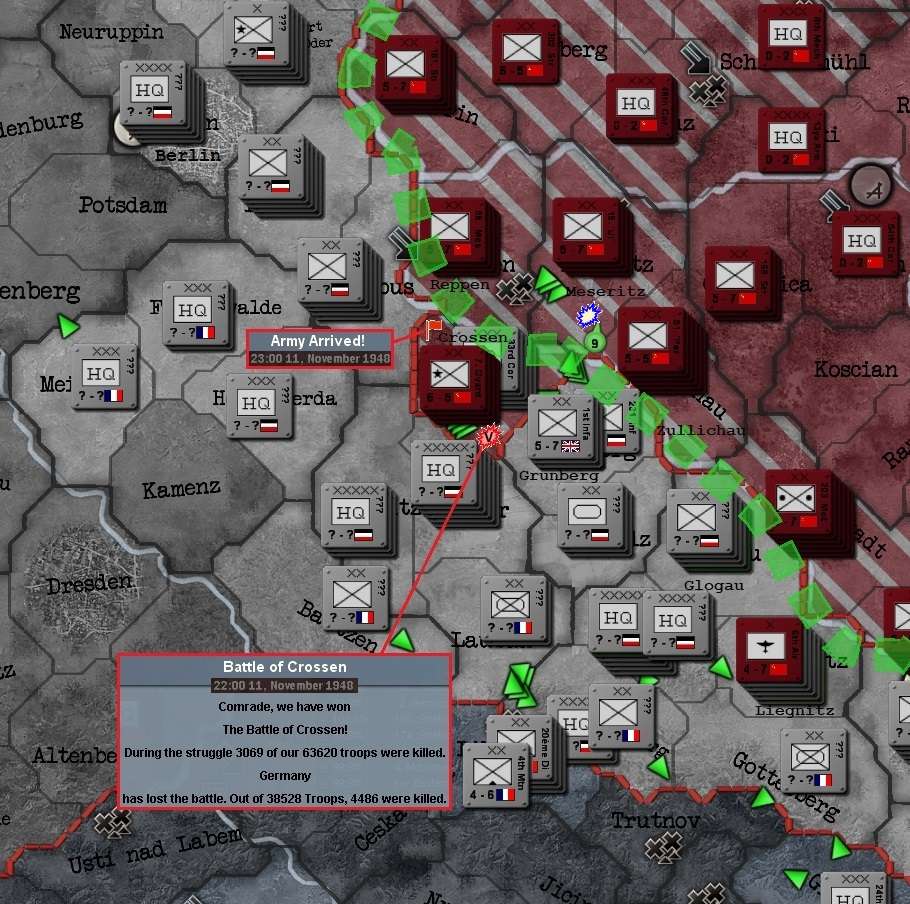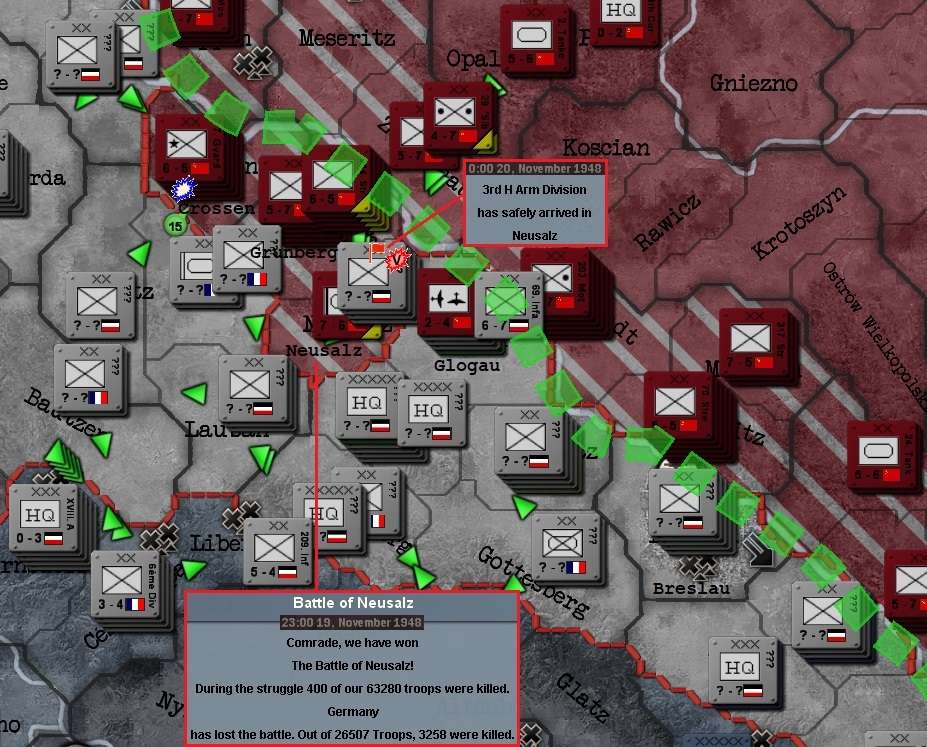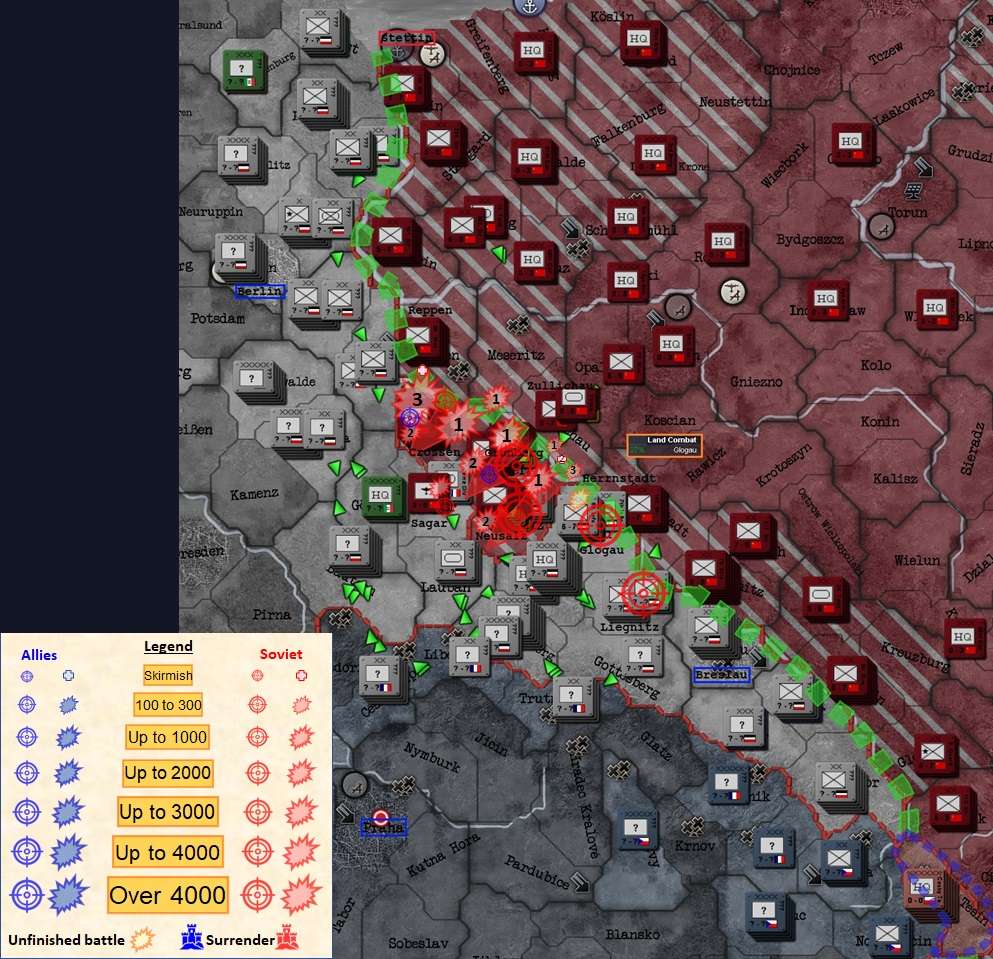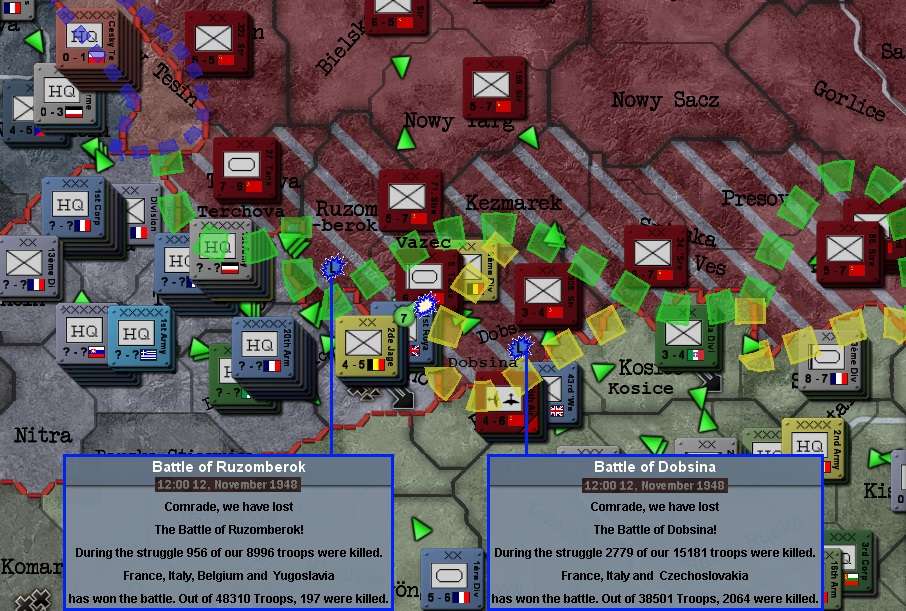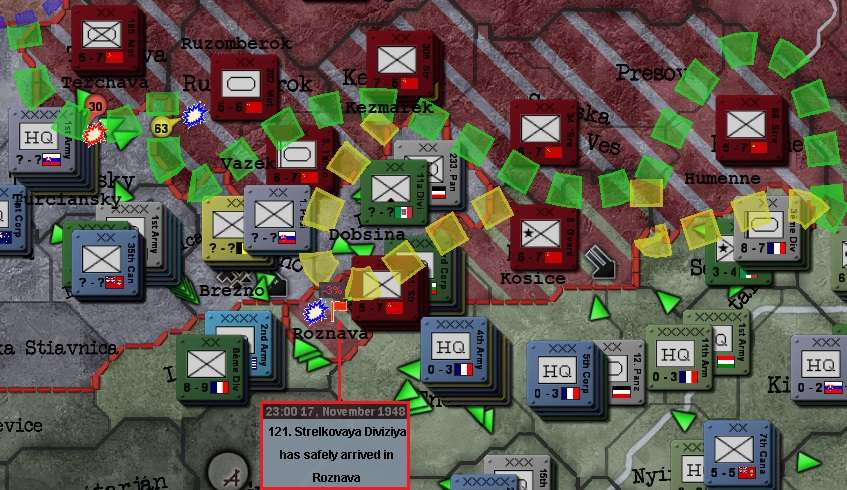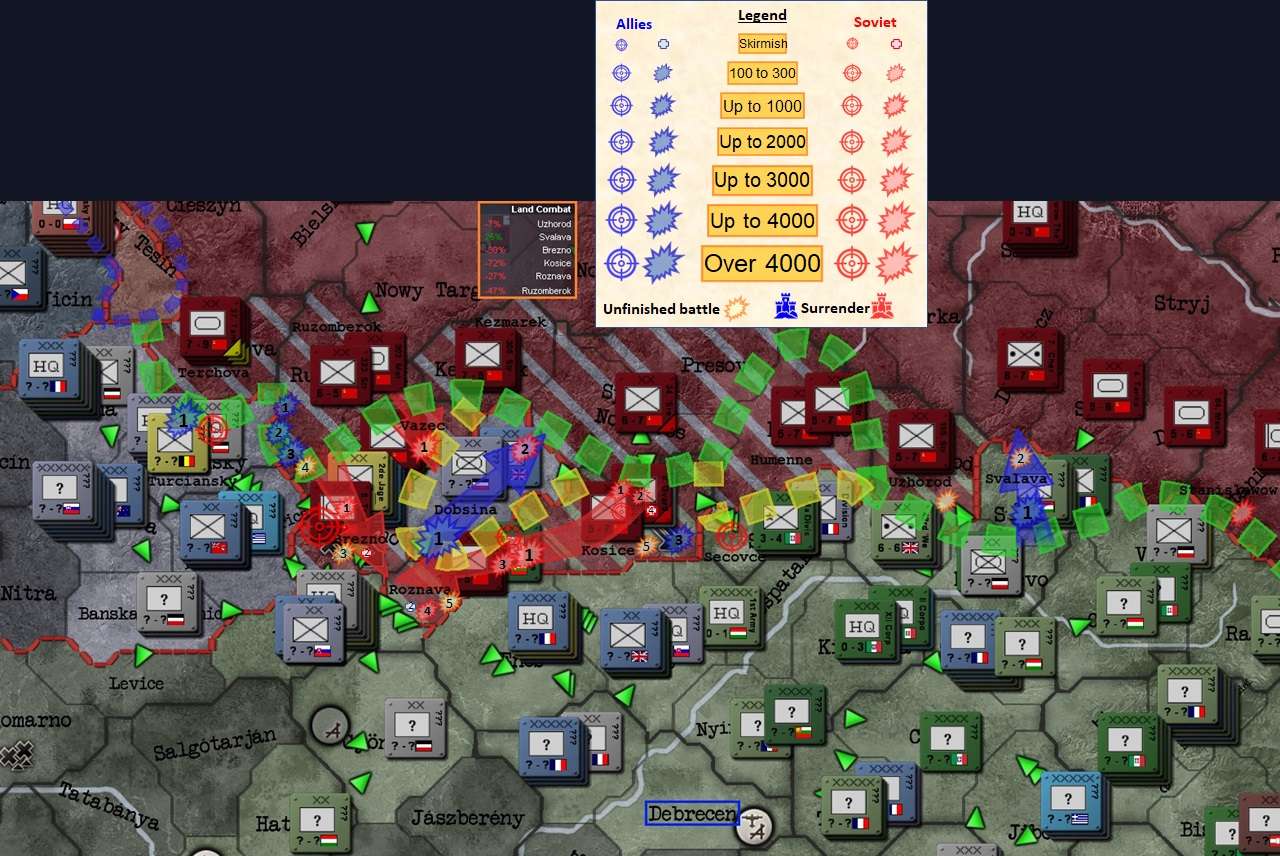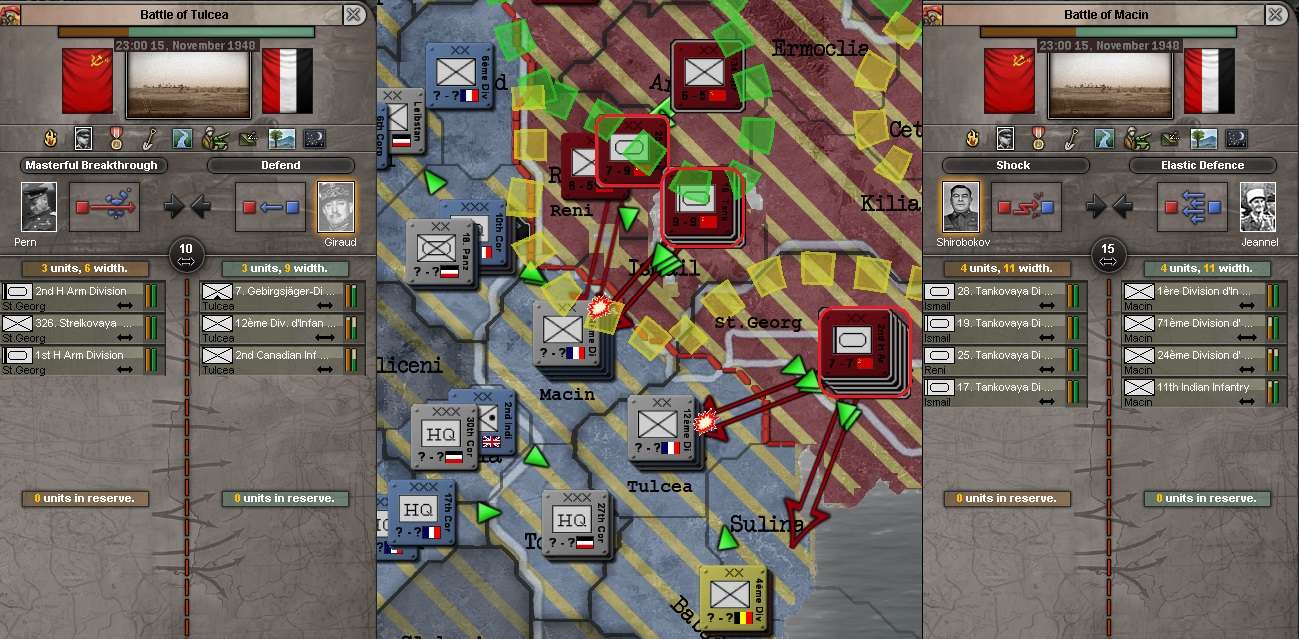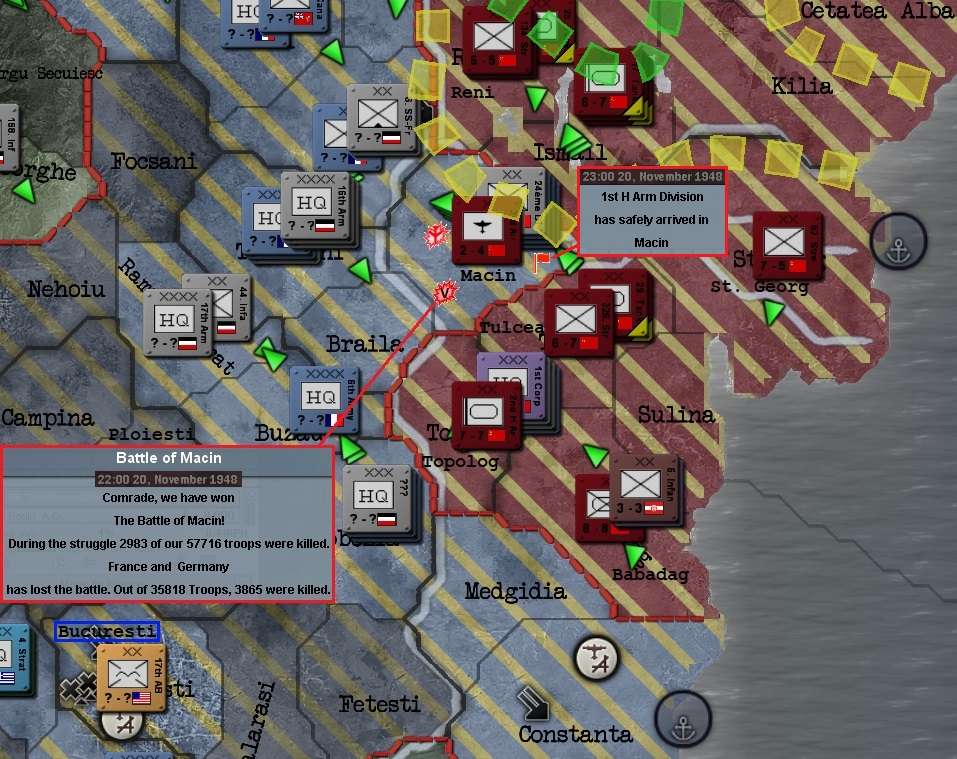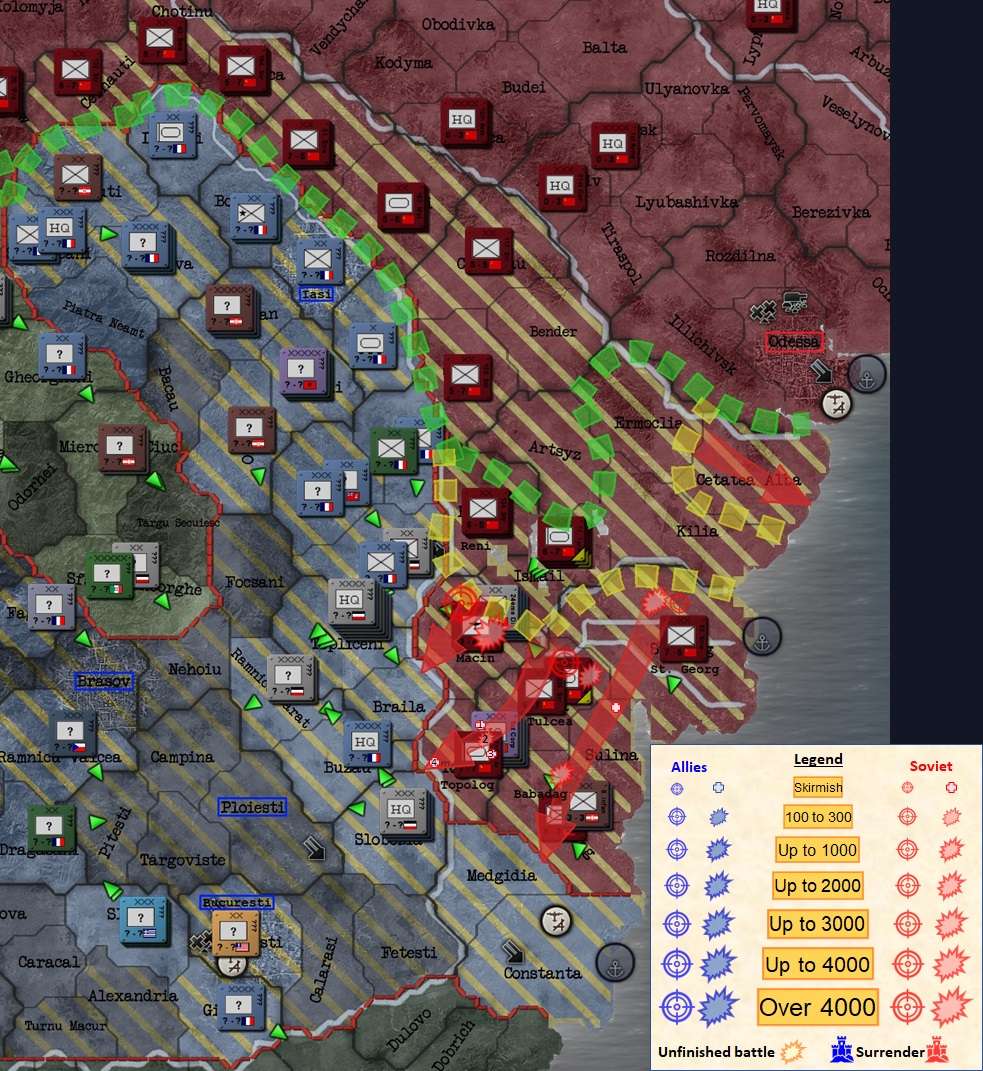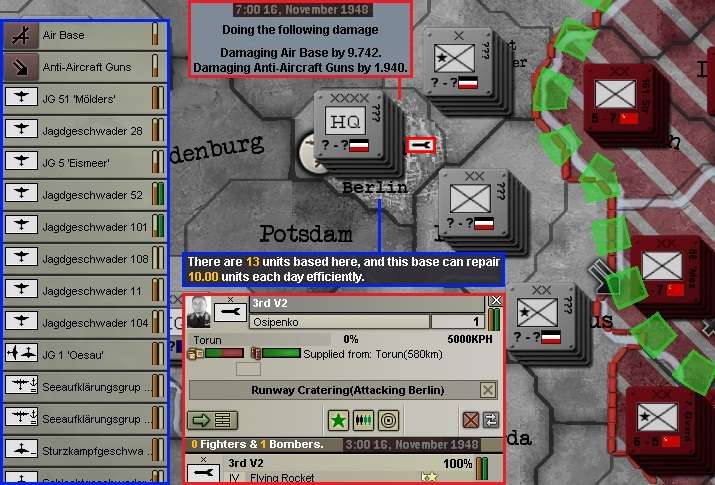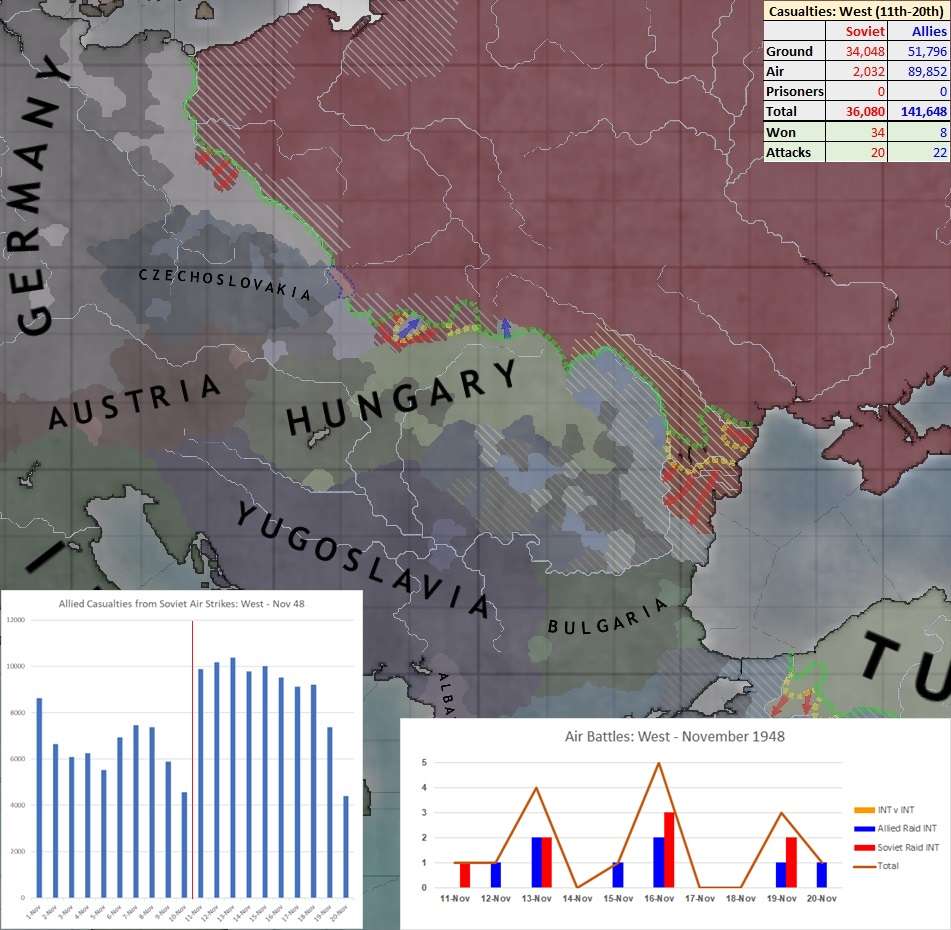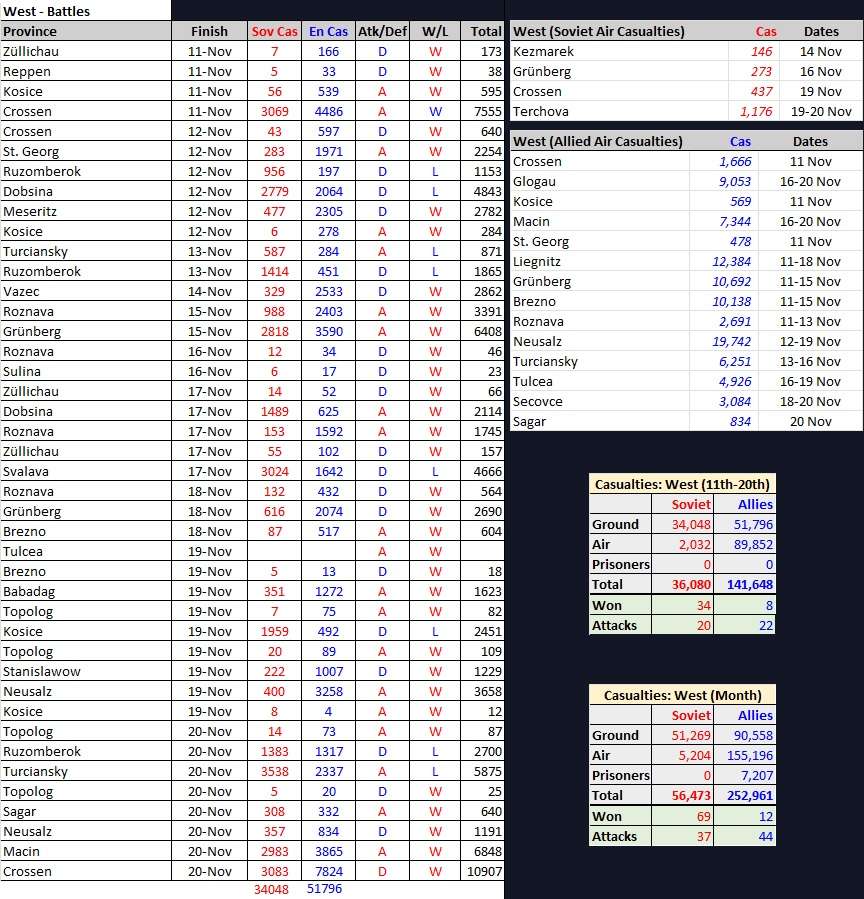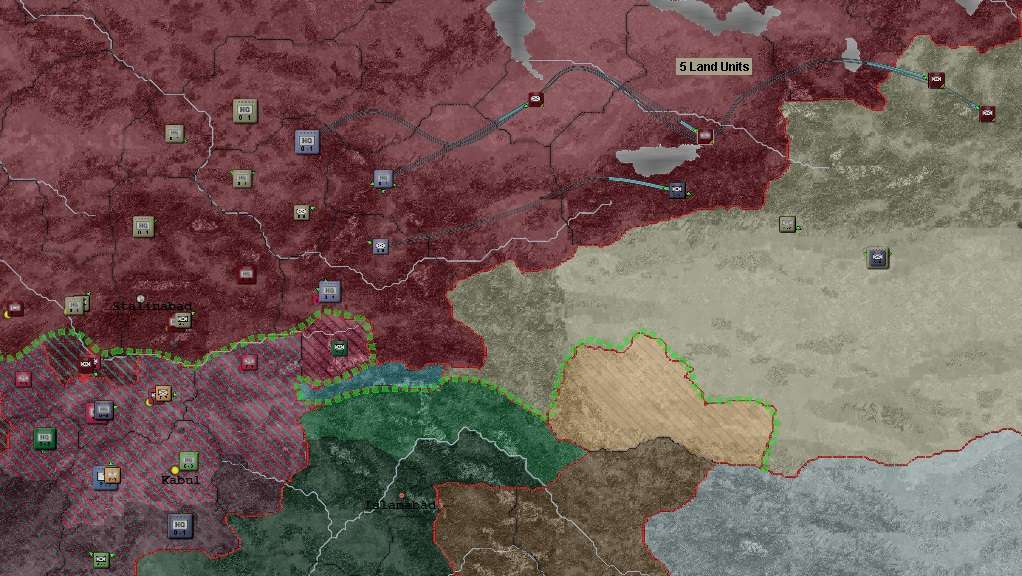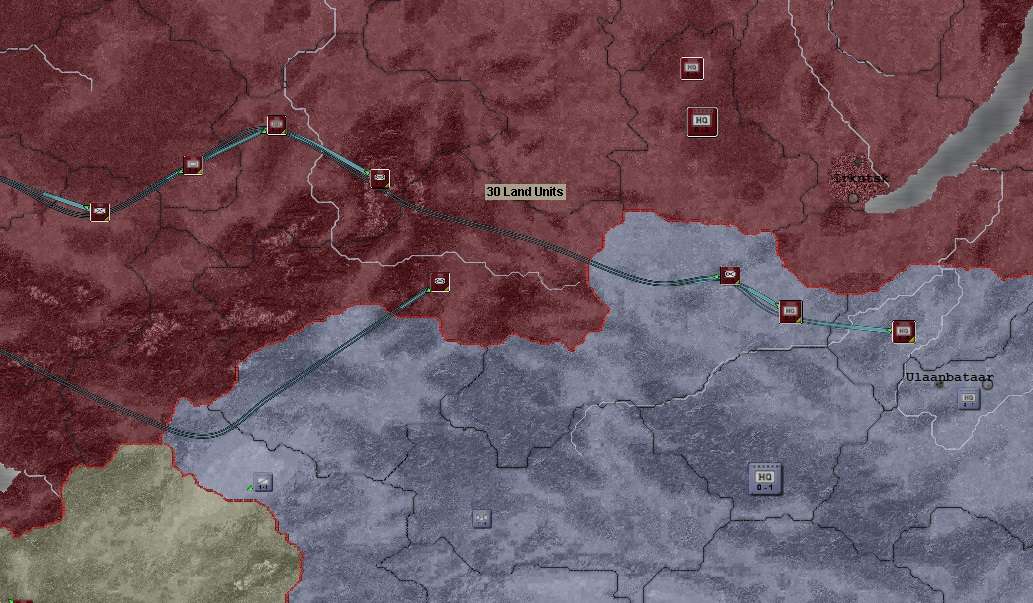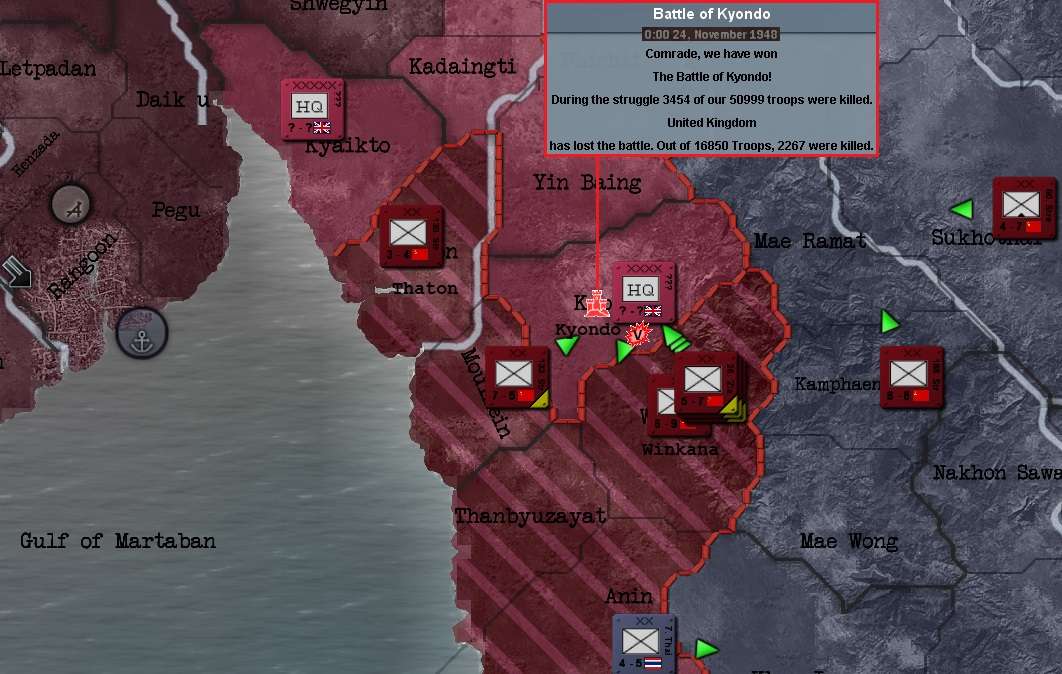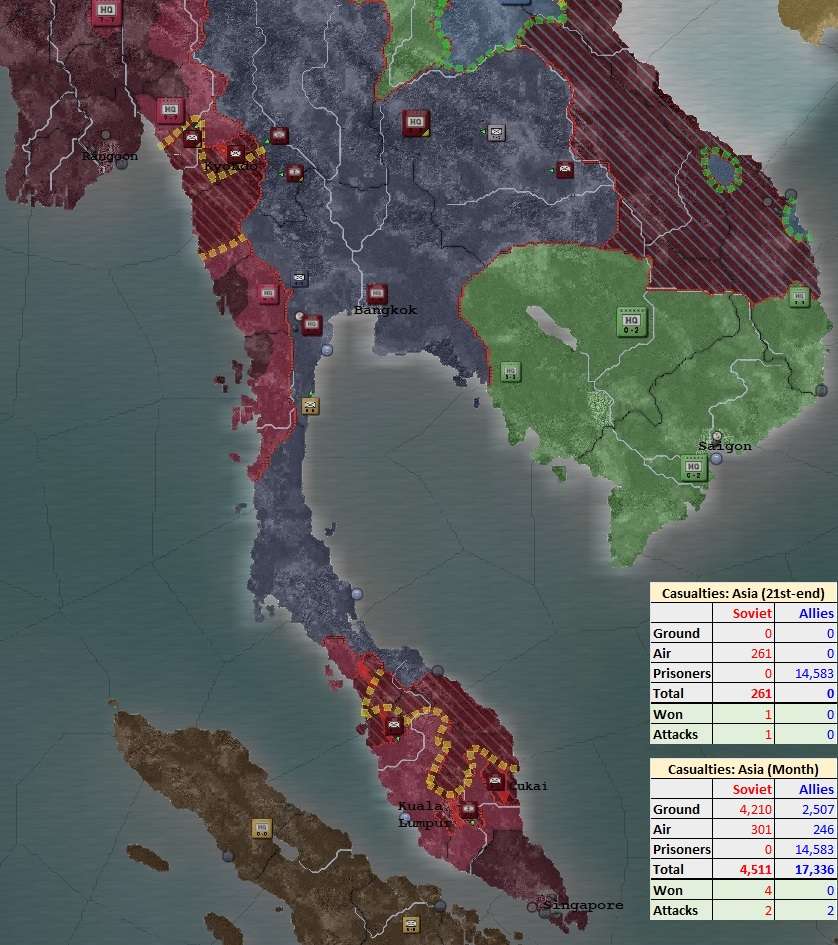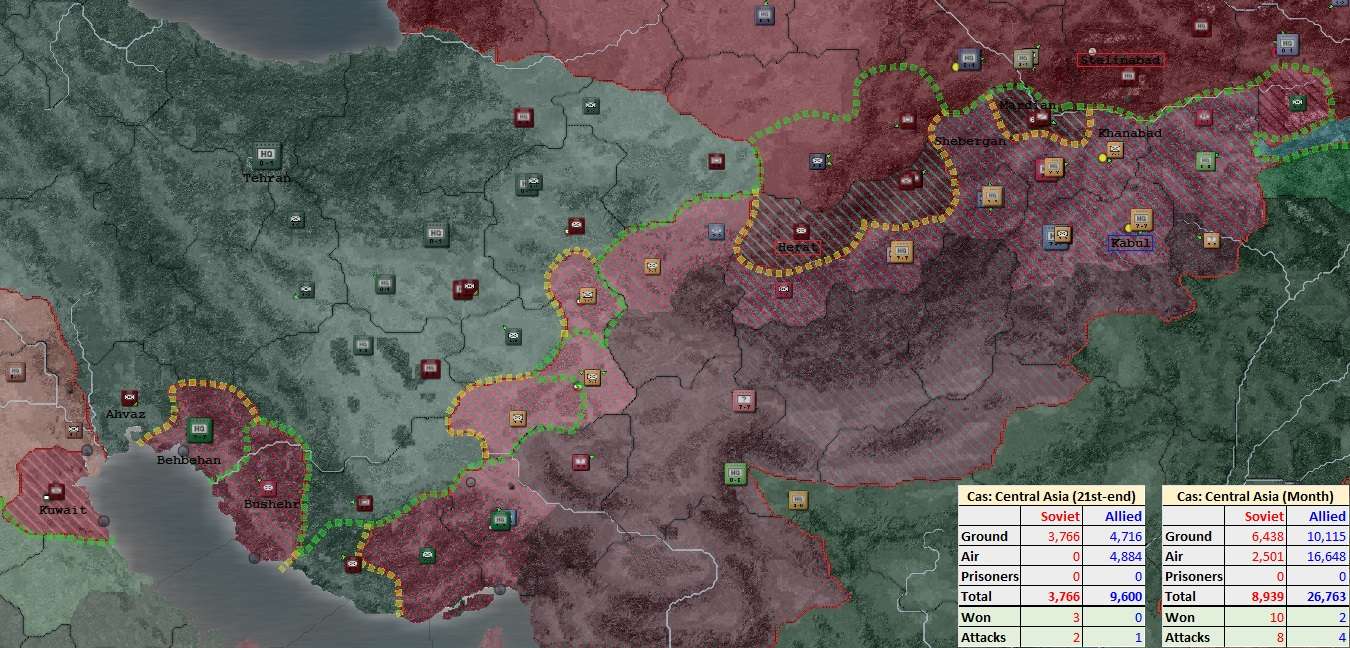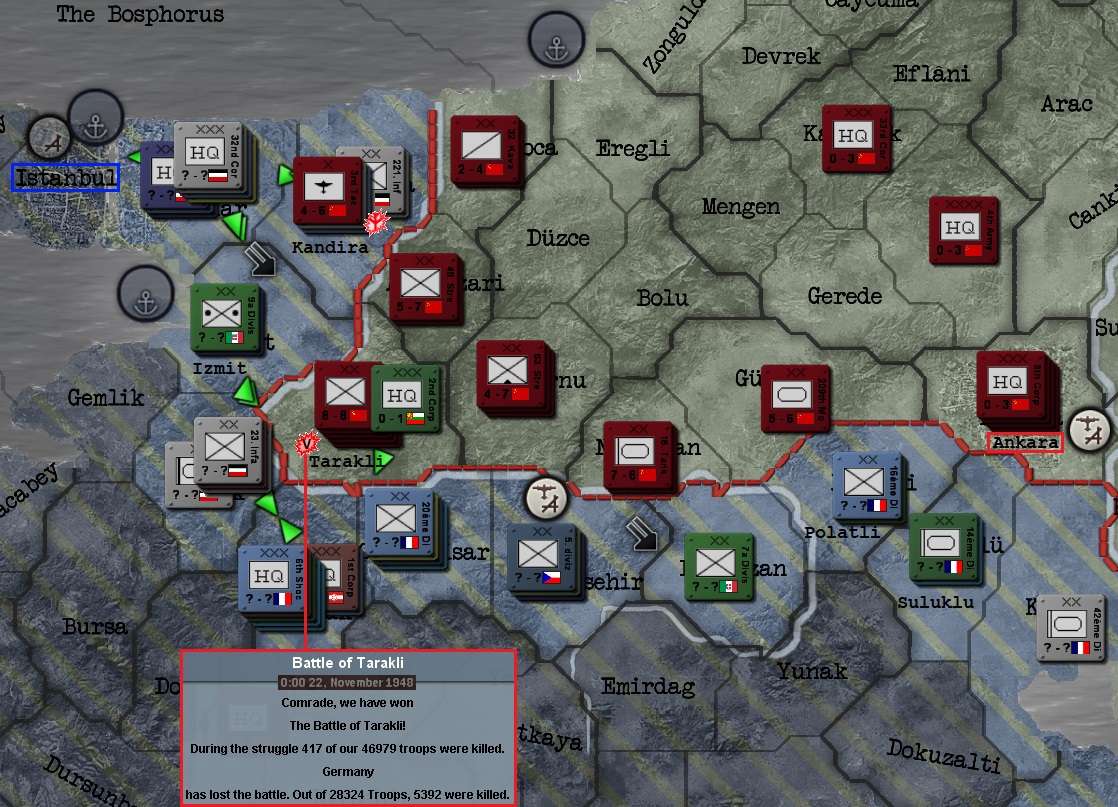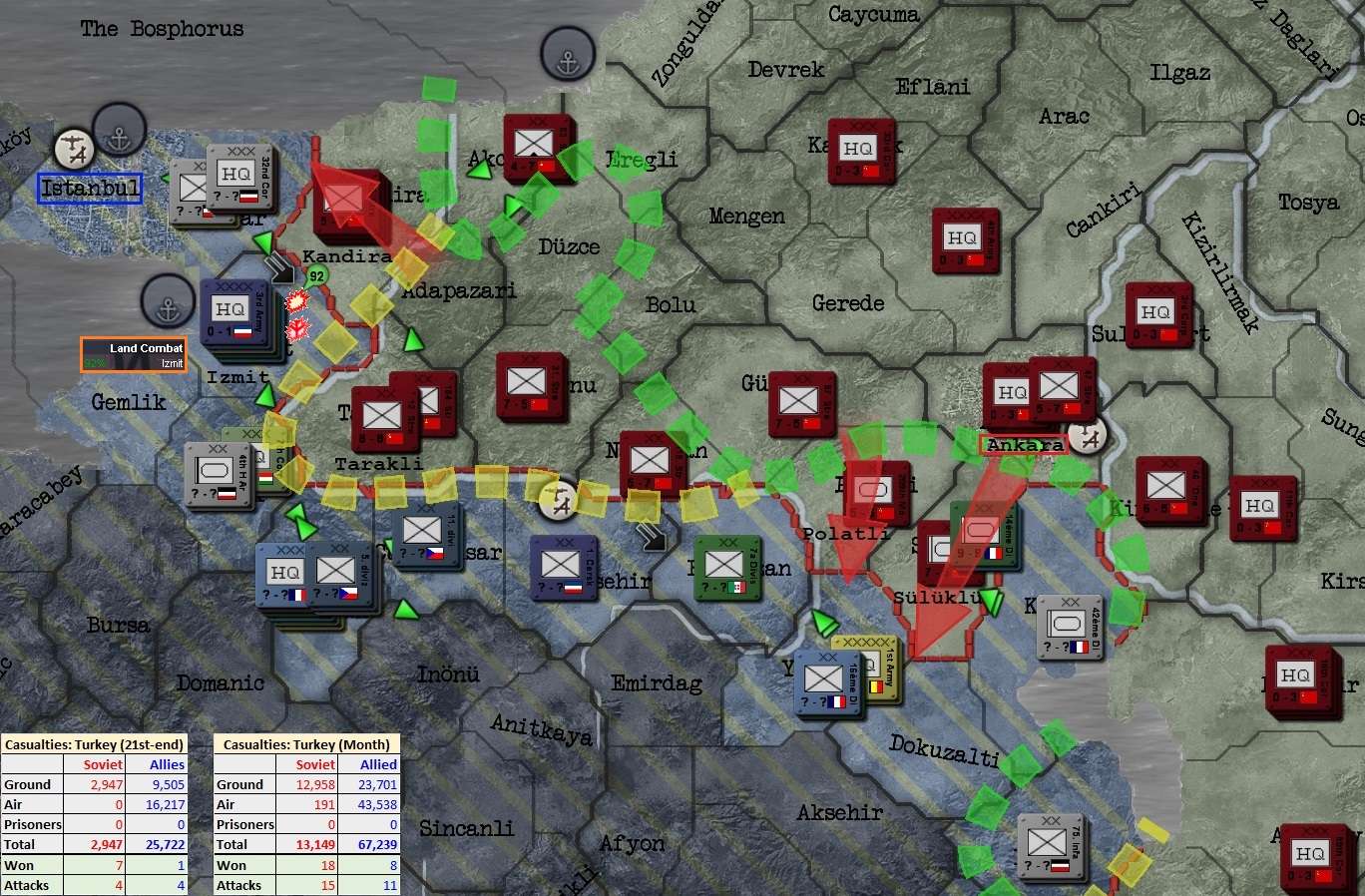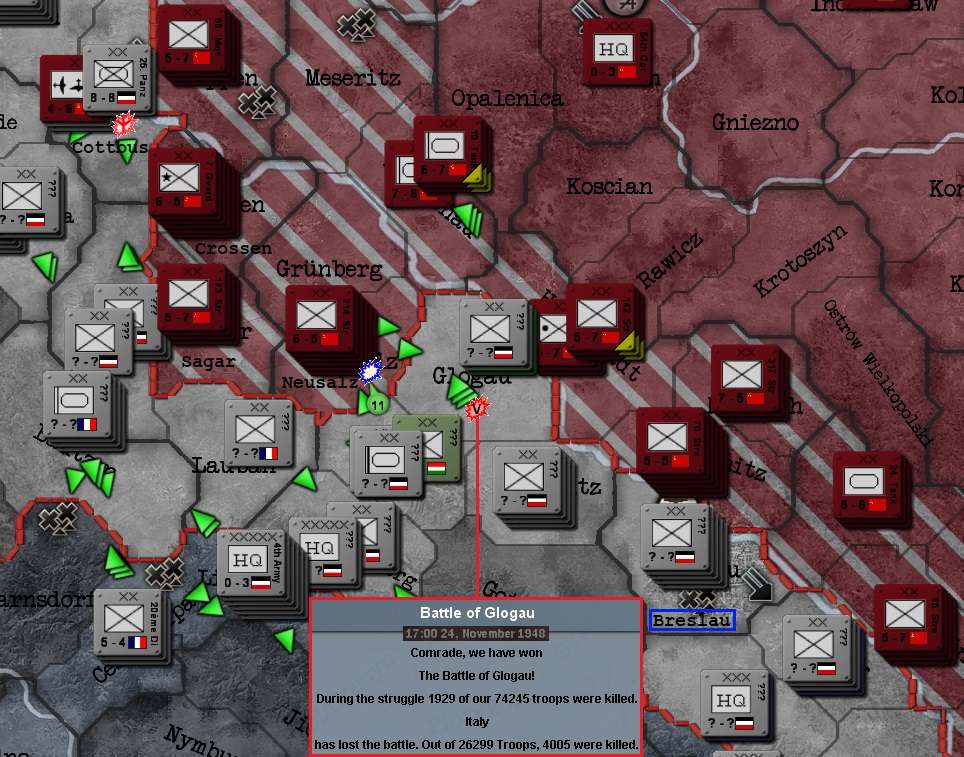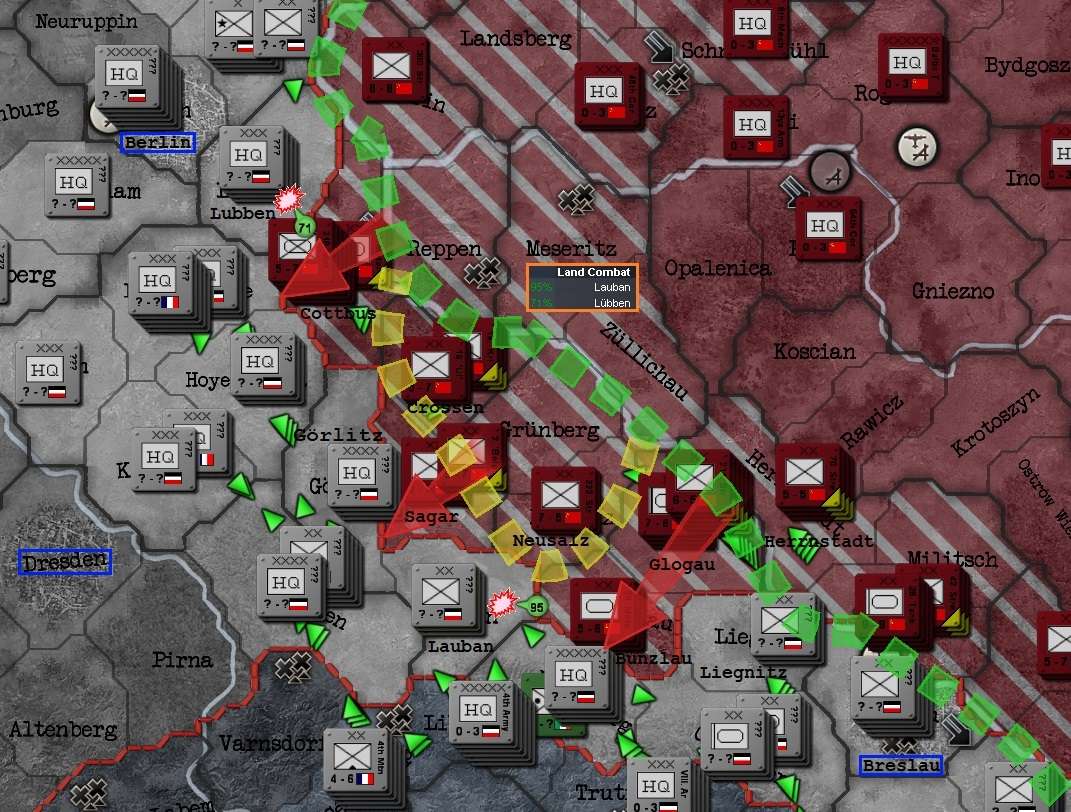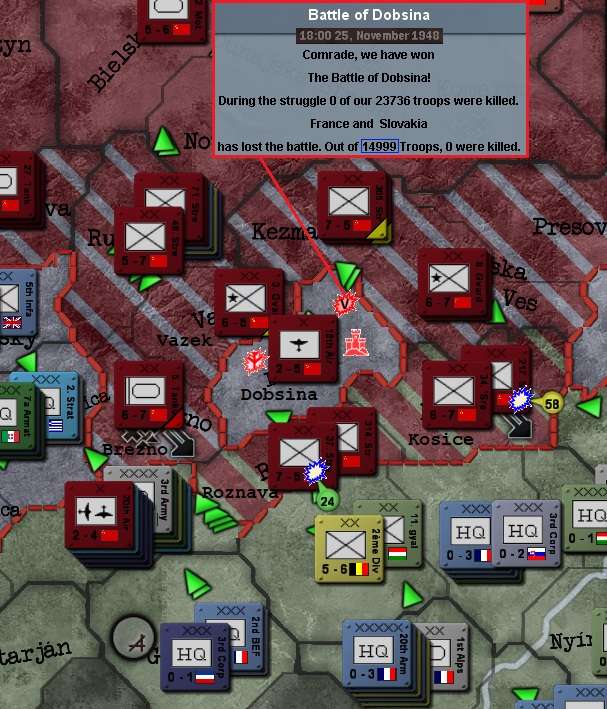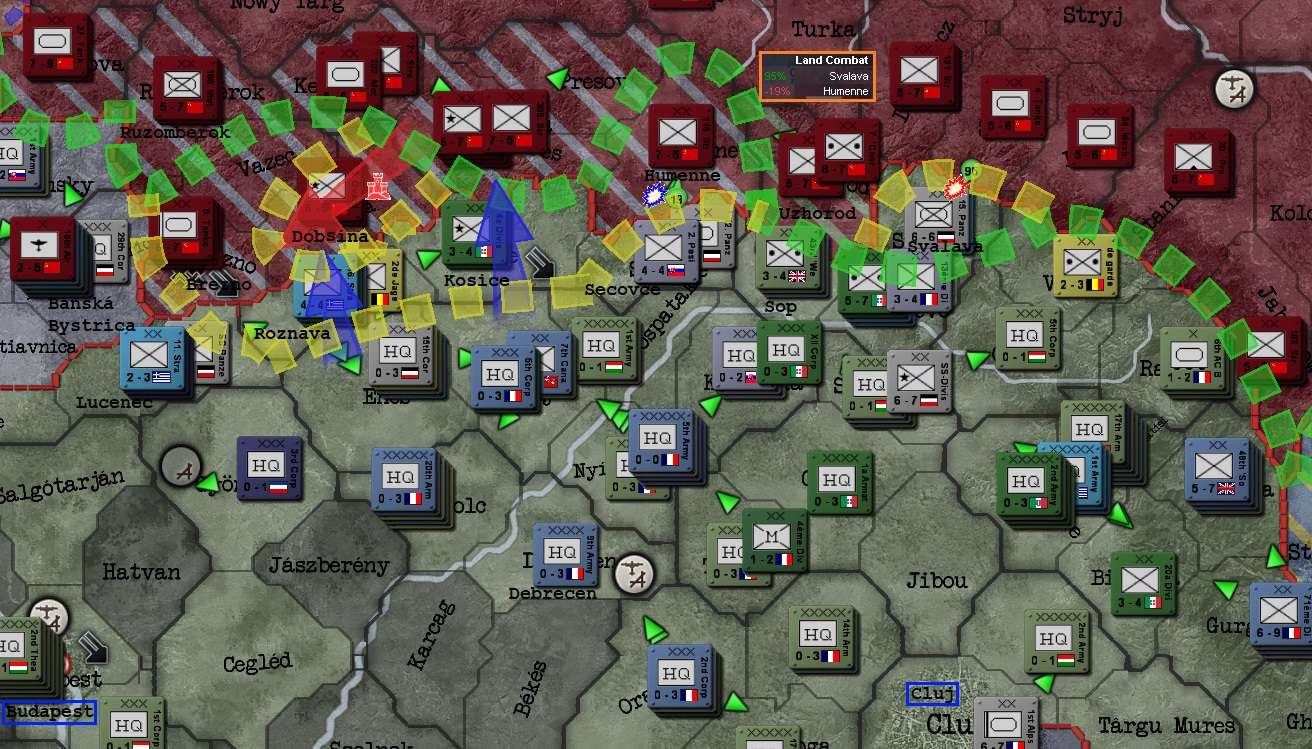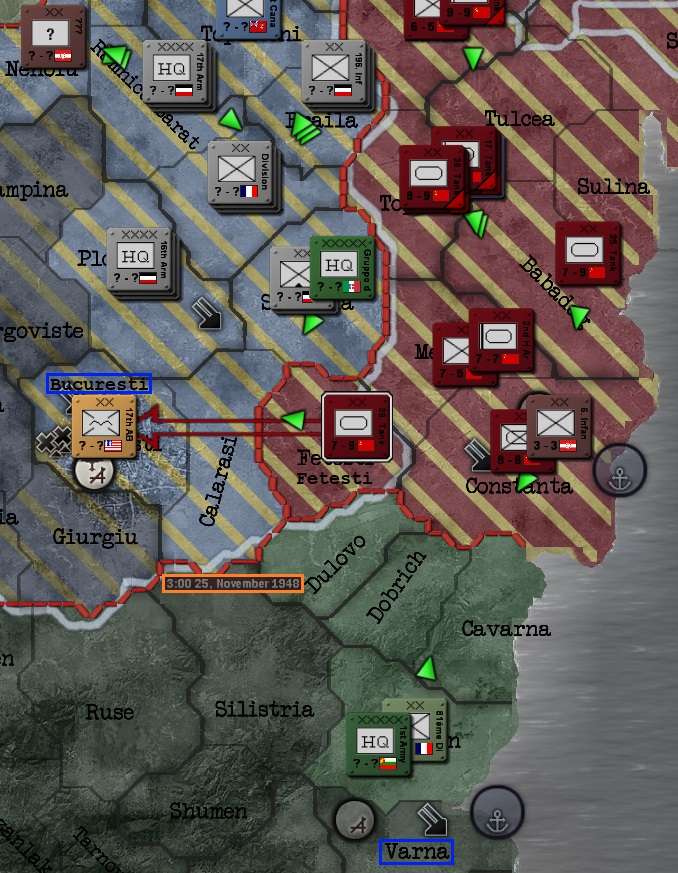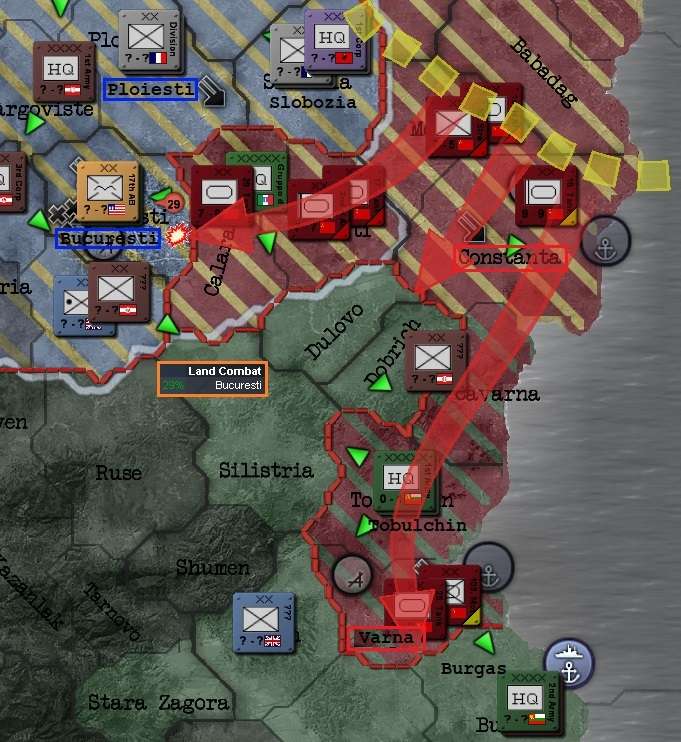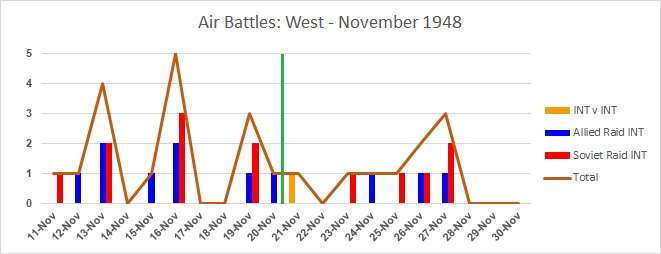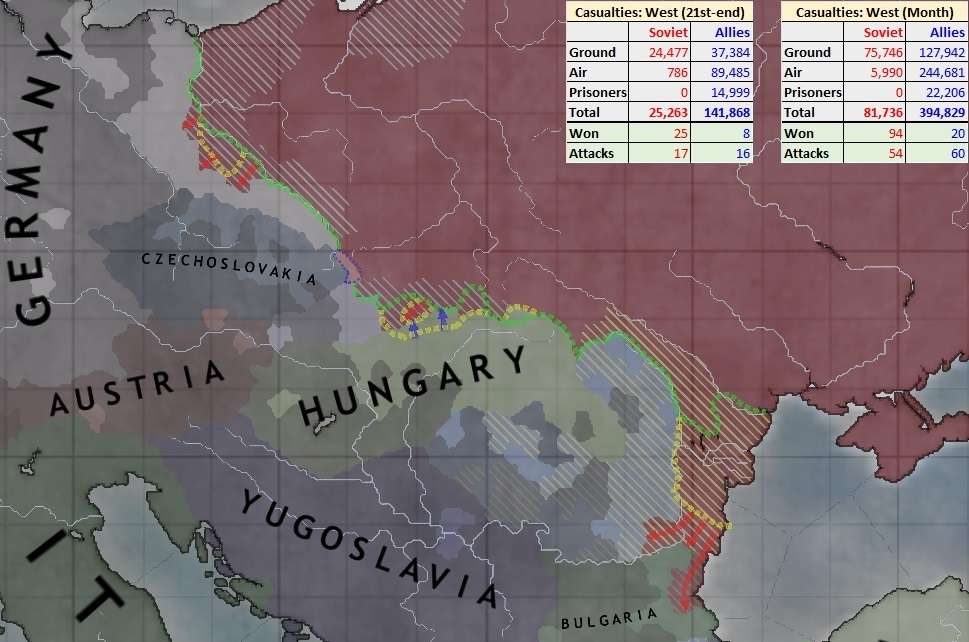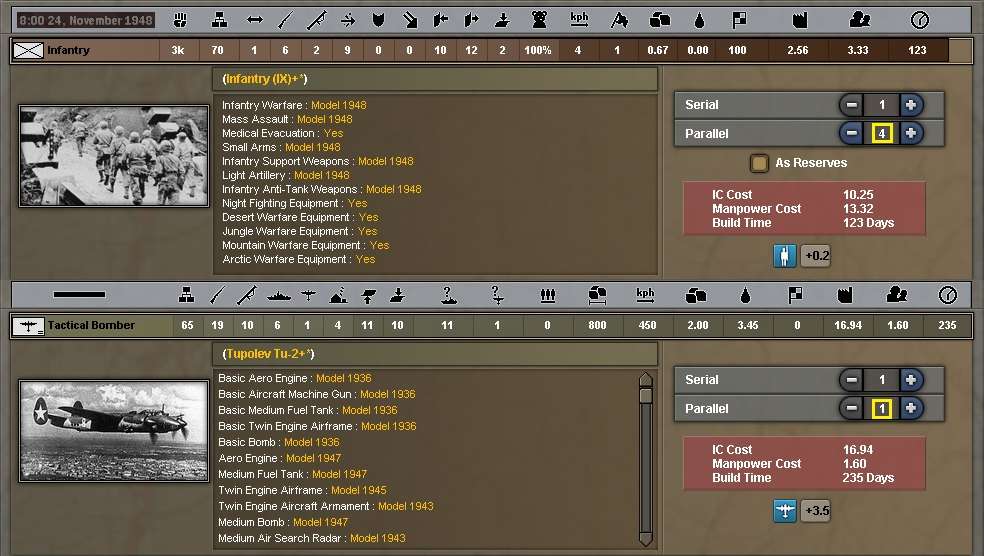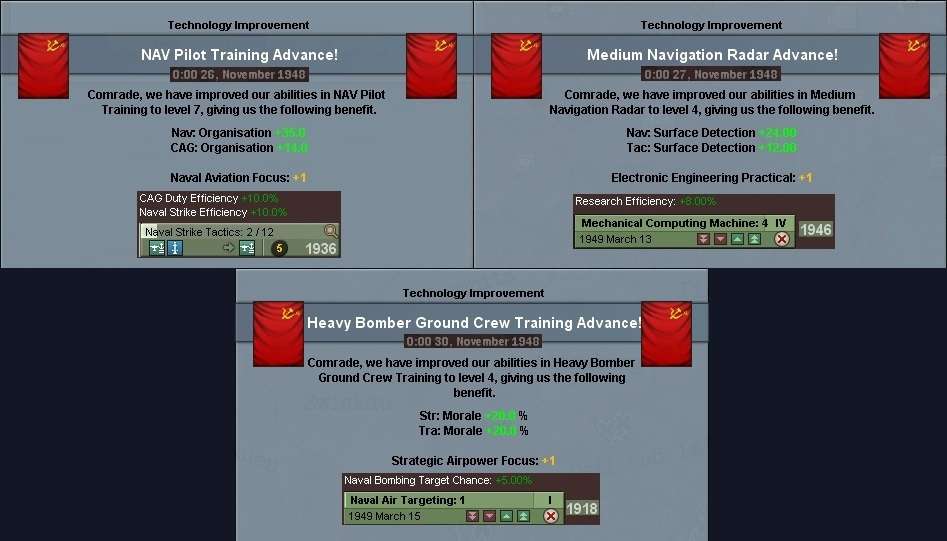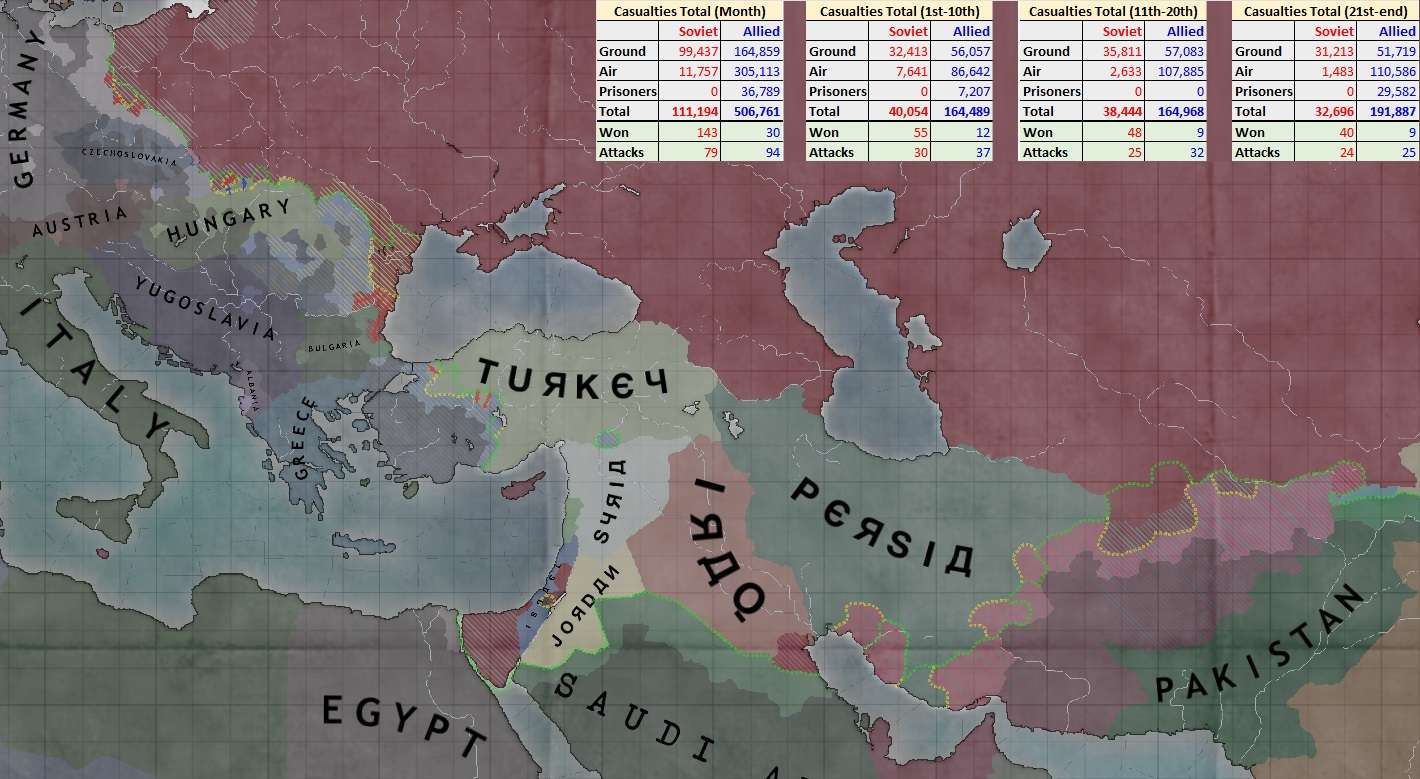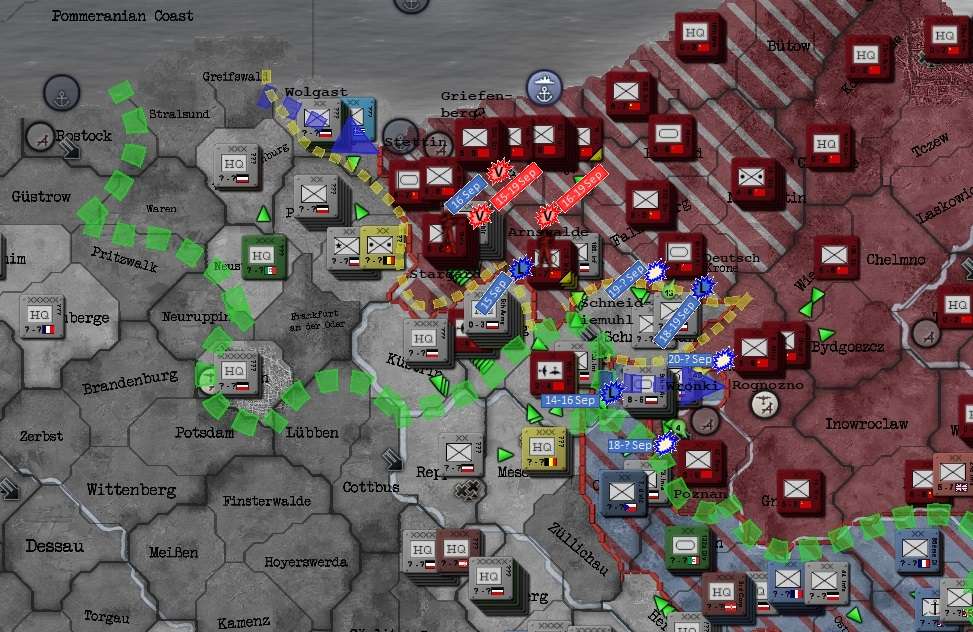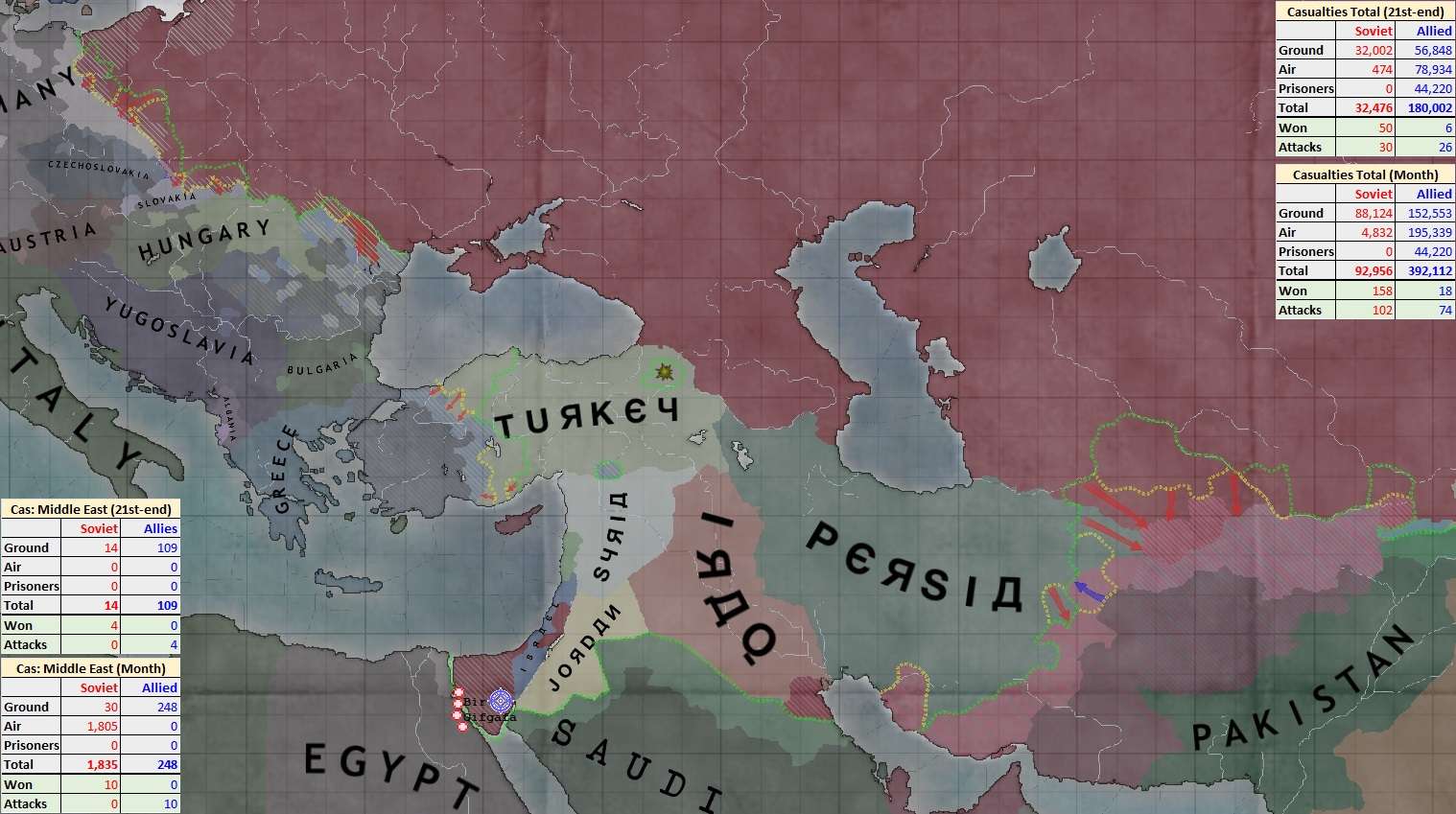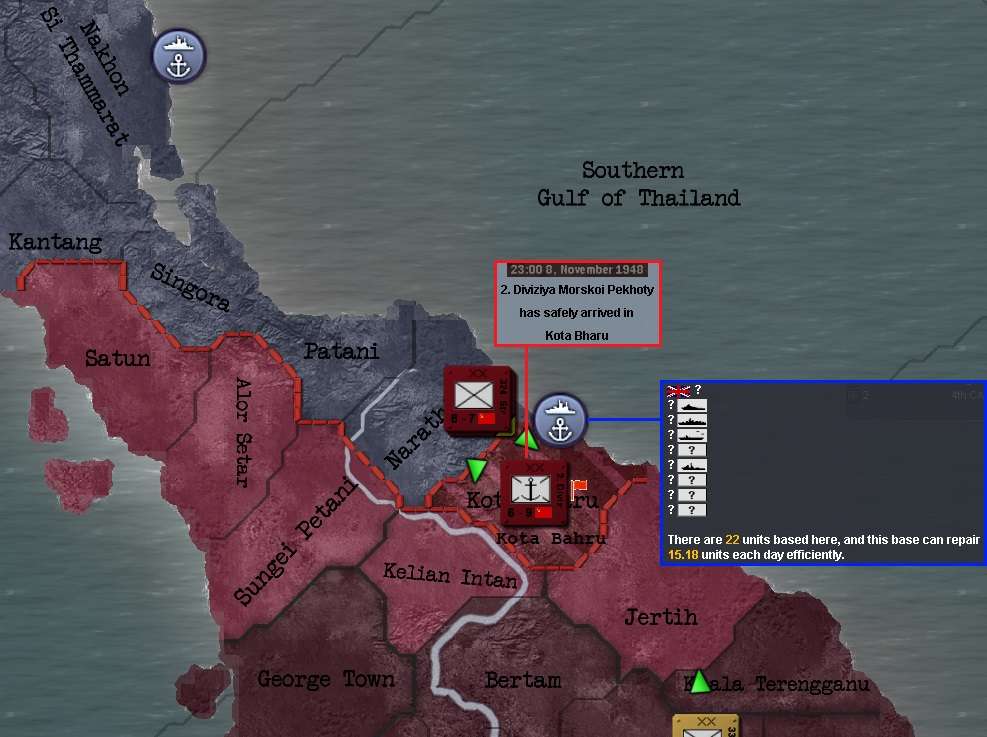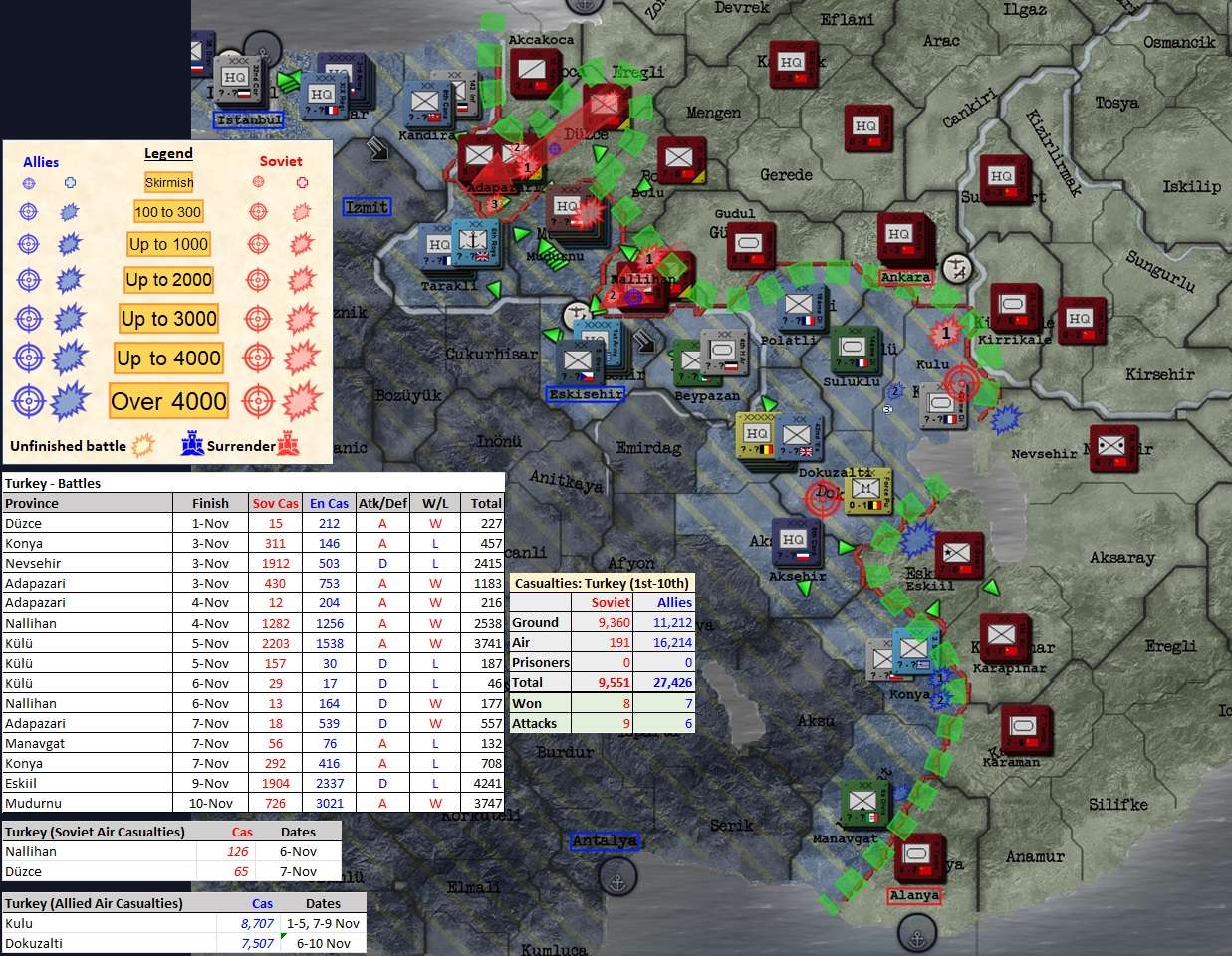Chapter 58: 11 to 20 November 1948
******
1. Asia
By 13 November, the Soviets had begun making inroads into Malaya. One division was sent north-west to secure the resource-rich Alor Setar. The other two divisions would strike south to Kuala Lumpur and along the coast towards the rubber plantations of Kuantan. If they were lucky, these three divisions may prove enough to secure the peninsula all the way down to Singapore. If not, reinforcements would be called in from the Far East reserve now moving through the recently opened northern Vietnam corridor.
In Burma, the Soviets won a somewhat expensive defensive battle at Thanbyuzayat on 15 November and then countered with an attack on the British armoured divisions that had been attacking from Kyondo.
By 17 November, the attack on Kyondo continued
(+57% progress), while Soviet infantry was in Moulmein and heading north to Thaton. If they could secure it, this would cut off the British in Kyondo in an ‘infrastructure pocket’.
That was achieved early on the 20th, as other Soviet divisions moved to complete the encirclement to the east and west of Kyondo.
Map showing provincial infrastructure levels.
As the period ended, the Soviets were happy with their progress, as the Far East Reserve force approached the Thai border south-west of Hanoi.
The Asian Theatre as at 2300hr on 20 November 1948.
******
2. Middle East
The by now customary probes and air strikes on Bîr Gifgafa were launched, but none succeeded. The guerrillas in Hebron remained in place as the Soviet response force made its way to confront them from Adana.
The Middle East as at 2300hr on 20 November 1948.
******
3. Central Asia
325 SD finally finished its long advance on Lamard on the morning of 13 November. This cut off the Allied troops on the Persian Gulf coast by land, but they did have two ports under their control and a wide-open northern flank.
The determined defence of Mardian by the Red Army ended at midday of the same day, aided by continuous defensive air missions on Khanabad, which would continue right through the reporting period (Soviets 250/26,832; Allies 1,575/14,117 killed). Then at 2200hr that night, Afghanistan’s second city of Herat was liberated and a hasty Nepalese counter-attack brushed off.
A week later, the Soviets were ready to launch an attack on Bushehr, even as the Allies sought to advance from Behbehan on an Iranian division dug in at Yasuj. The Bushehr attack was on precisely even terms as it began, due to the favourable defensive terrain, which offset the superior tactics and heavy armour of the Red Army attackers.
The VVS raids on Khanabad were by far the most significant cause of Allied casualties during the ten-day period. Soviet gains at Lamard on the Gulf and in northern Afghanistan were partly balanced by Allied progress against the Iranians in the centre.
The Central Asian Theatre as at 2300hr on 20 November 1948.
******
4. Turkey
After the heavy activity of the first ten days of November, fighting was far more limited during this period. Mudurnu was occupied on the morning of 11 November, where the Red Army managed to fend off a determined Allied counter-attack by the 13th in the largest single battle of the period.
This laid the foundation for a successful attack on Tarakli, securing the river line and inching closer the Bosporus. Air preparation on Kandira was interrupted for a few days from 16 until 18 November, when the TAC group was diverted temporarily to support a new offensive in Romania. But they returned for the last few days, in an attempt the continue the softening up process.
Kandira was well defended, with German and other Allied troops dug in in mountainous terrain and with a river in front of them. Any further progress would be difficult. And elsewhere on the front, neither side had sufficient advantage to push the other from their strengthening defensive positions.
In the air war, an RAF STRAT raid on Majkop was intercepted and harshly dealt on 17 November, but not before its facilities were heavily damaged. The only air battle of the period occurred when three Luftwaffe INT wings tangled with a combined VVS force of 2 x INT and 2 x TAC over Kandira on 19 November. The other two VVS INT wings in Batumi had to be reserve hopped over to Odessa before they could be in range to offer addition support, which they were able to by the end of the dogfight. The German fighters were badly disorganised by the end of the dogfight, but one of the original escorting VVS INT wings was reduced to around 40% strength and had to be rotated out for a rested wing afterwards.
Tarakli had been taken and an Allied counter-attack almost defeated as the reporting period ended. But further progress was likely to be slow and bloody as the Soviet front again became stretched and the Allies took advantage of strong defensive lines. Once more, the VVS had caused the lion’s share of enemy casualties.
The Turkish Front as at 2300hr on 20 November 1948.
******
5. The West
As before, the most intense action remained the bitter fight on the Western Front. It was concentrated into three quite specific areas: a river crossing attempt north of Breslau, a series of attacks and counter-attacks along the Slovakian-Hungarian border and the continued offensive in Romania. Given its significance, the air war in the west will be treated as a ‘fourth sector’.
******
5.a Germany-Poland
The great attack to secure a river crossing at the appropriately named Crossen finally ended in a bloody Red Army victory late on 11 November. A heavy air bombardment continued at Crossen and to its south-east along the area of the intended expansion of the bridgehead.
On the 15th, the bridgehead was expanded south-east to include Grünberg (Soviets 2,818/75,836; Allies 3,590/27,219 killed). After that had been consolidated and more troops pushed across the river, the next attack was launched on Neusalz at 1700hr on 18 November, even as a major Allied counter-attack on Crossen played out.
The attack on Neusalz was far less expensive for the Soviets this time, with more troops already across the river and previous heavy air preparation. Neusalz was occupied very early on the 20th. More troops would follow, while the VVS concentrated on striking Glogau and Crossen still resisted the Allied attempt to oust them.
At 0200hr, even as the defence of Crossen continued, the Allied attackers in Sagar found themselves under attack from three divisions in Grünberg as the Red Army now began trying to deepen the bridgehead in between Berlin to the north and Breslau to the south. The Soviets would find victory there by 1500hr that afternoon.
The Allies launched an attack on Neusalz from Glogau that afternoon, but the Soviets responded with a three-division cross-river spoiling attack on Glogau from Hernnstadt at 1700hr. As the day drew to a close, the defence of Crossen was finally won, but not before almost 11,000 troops from both sides had perished in the ground fighting alone.
The concentration of fighting in eastern Germany around the bridgehead operation is starkly illustrated below. Heavy ground fighting to take and then hold the initial lodgement at Crossen was accompanied by an expansion of troops so crossed to the south-east in phases, accompanied by extremely heavy VVS air preparation and occasional Allied responses. A summary of the air war is provided later.
The German-Polish sector as at 2300hr on 20 November 1948.
******
5.b Slovakia-Hungary
This sector proved to be a very busy one, as both sides traded attacks, counter-attacks, spoiling attacks and ferocious defence and the line ebbed and flowed, with the Allies putting in a concerted effort to reverse Soviet gains.
The Soviets occupied Vazek at 0300hr on 11 November and were immediately counter-attacked by three Allied visions, but they would hold on to secure it, even as Dobsina (occupied in the previous period) to its immediate east continued to weaken under another Allied attack
(-58%).
The next day, the Allies won substantive victories in Ruzomberok and Dobsina at midday.
But three hours later, the defence of Ruzomberok resumed as a fresh division pulled in to mount a hasty defence – against five full-strength Allied divisions attacking from Turciansky and Banská Bystrica.
The next major development came at midnight on 14 November, when the Allies reoccupied Dobsina, even as Kosice had been taken to its east and a strong Soviet attack
(84%) mounted from there on Roznava to the south of Dobsina continued. One Soviet division attacked two worn ones in Dobsina
(73%) within the hour, to see if the Allies could be quickly thrown back out.
But to the east, a superior Allied force had the upper had in an attack on Svalava (northern Hungary), with the overpowered defenders being withdrawn at 1500hr on the 17th (Soviets 3,024/15,993; Allies 1,642/34,736 killed).
By the end of that day, the battle for Roznava had been won and it had been occupied. This exposed both the advancing Soviet troops and the Allies still holding on in Dobsina to its north.
Bulgarian troops occupied Svalava at 0300 on 18 November but were counter-attacked straight away, forced to retreat back south after a brief skirmish.
Meanwhile, to try to complete an encirclement of the Allies in Dobsina, the Soviets had struck south to Brezno, where they won the battle (with heavy air support) on 18 November and occupied it at 0100hr on the 19th, thus surrounding the Allies in Dobsina. But even as that was happening, a strong Allied attack on Kosice
(-88%) was threatening to break the recently completed encirclement, while the most recent defence of Ruzomberok was also in some trouble (-66%). The battle for Kosice would be lost and the Allies retook it at 2300hr that night, but a Soviet counter-attack was launched straight away by two fresh infantry divisions, which defeated the recently arrived 12 Pz Div after another very brief skirmish.
The second defence of Ruzomberok was ended early on 20 November, as two more Soviet divisions (neither of them yet completely rested from earlier fighting) were returning to the fray to carry on the fight, as a soiling attack on Turciansky continued and the Allies tried to break out of Dobsina at Brezno.
But the spoiler on Turciansky was proving expensive, so it was called off at 0500hr (Soviets 3,538/26,994; Allies 2,337/55,660 killed). The third defence of Ruzomberok began an hour later
(-40% initially).
As the period ended, Kosice was retaken by the Soviets, then it and Roznava were both attacked by the Allies an hour later, while the enemy also inched forward a little in Ruzomberok. The whole sector remained fiercely contested and the Allies generally on the attack and supply problems hampered the Soviets in and around Kosice.
Overall, the sector had been very active during the reporting period, with six battles (five of them Allied attacks) in progress as it ended. Most fighting had occurred between Ruzomberok in the west to Kosice in the east, as the Soviets tried to maintain their encirclement of Dobsina then muster the strength to close it out, which they had not yet been able to do.
The Slovakian-Hungarian sector as at 2300hr on 20 November 1948.
******
5.c Romania
A battle was fought to take St. Georg (the Danube River delta) and won on 12 November, after which it was occupied. Then behind it Cetatea Alba, where the Allies had been encircled and surrendered some days before, was occupied on 13 November as Red Army divisions moved forward into starting position for the next offensive in the south of Romania, to force the next river crossings.
This began late on the 15th, with three simultaneous advances, one of them against the unoccupied Sulina, the rest against significant Allied defences and across rivers. Initial progress was slow in Macin and Tulcea, where air power was used to supplement the ground attack.
By the evening of 16 November, the two attacks were only slowly gaining momentum (
Macin 42%, Tulcea 31%) while an Austria division was seen making for Sulina, which the Soviet armour approaching it had not yet arrived.
29 Tk Div won the race for Sulina and had brushed off a quick Austrian probe and then begun a flank assault on Tulcea from the south at 0100hr on the 17th, just as that attack had been losing steam (30%), as was that on Macin (38%).
It too until the early morning of 19 November to win the battle for Tulcea and occupy it, allowing a four division flank assault on Macin to aid that attack, where the Allies still defended staunchly. Then Topolog, to the south of Macin, was taken at 0500hr on 20 November, after three quick attacks on Allied units that had been retreating through it from Tulcea, followed by a fourth skirmish when it was taken and held by 2nd HArm Div.
Victory finally came in Macin late on the 20th after the toughest battle in the sector during the period and it was occupied an hour later. The VVS had caused a further 7,344 Allied casualties in Macin from 16-20 November and earlier in Tulcea had accounted for another 4,926 from 16-19 November (by the Odessa-based TAC group that had been temporarily diverted from the Turkish Front to assist the breakthrough.
As the period ended, the latest offensive had reached the east bank of the next river line at Macin and Topolog while forces pushed south towards Constanta, on the Black Sea border with Bulgaria, with forces having pushed as far south as Babadag.
The Romanian sector as at 2300hr on 20 November 1948.
******
5.d The Air War in the West
Once again, the relentless VVS bombing campaign killed far more Allied soldiers in the West than had been caused by ground combat. In fact, it just exceeded the entire combined ground combat casualties of both the Allies and the Soviets in the West during the ten-day period. So a short overview of what went on in the air is warranted, as the Allies were not passive during this time.
On 11 November, as the VVS bombing campaign was at a peak, four German INT wings (some in poor repair, but all fully organised) intercepted a large formation of bombers (2 x INT, 3 x TAC) over Crossen (while it was still under Soviet attack at that time). Another VVS fighter group (1 x INT, 1 x M/R) joined into the dogfight. And the mission was continued.
The same German fighter group then intercepted and mauled 2 x German CAS over Crossen on the 12th, after it had been occupied by the Red Army.
On 13 November, the second busiest day in the air for the period occurred as the Allies tried to disrupt the heavy Soviet aerial blitz. The German CAS were intercepted again over Crossen, when even though 2 x German INT came to their aid, one of the German CAS wings was apparently destroyed. At the same time the Hungarians (2 x INT) tried to return the favour on 3 x VVS CAS over Brezno in Slovakia. The latter turned into a full-on melee as 3 x German and 2 x VVS INT joined the dogfight.
Later that morning, the single remaining German CAS wing tried again over Crossen, without an escort, to be intercepted by the same three VVS fighter wings. The Germans had chosen …
poorly. Then in mid-morning, 3 x German INT took on a Soviet formation of 2 x INT, 2 x M/R and 2 x TAC over Turciansky, where they were supporting the spoiling attack for Ruzomberok.
After the Allies largely came off second best in these exchanges, there was a lull until 15 November, when a single dogfight occurred over Kezmarek as 2 x VVS INT intercepted 2 x Italian TAC who were trying to disrupt the attack on Dobsina that continued at that time. The Italians caused 146 ground casualties but were deterred from returning.
On the 16th, the air war reached a new level of intensity, as five dogfights were fought out on the one day. Two of these were Soviet interceptions of Allied raids and three saw the Allies trying to disrupt VVS bombing missions. After the early morning round, recon reports indicated that 13 Allied air units were in the Berlin air base, which had been fully repaired by that time. A V2 strike was ordered to ensure their repairs would be severely hindered for the coming days.
After another dogfight over Turciansky from 0700-0900hr, one of the escorting VVS M/R wings was almost destroyed, being detached mid-fight and only just limping back to base at 3% strength! The bomber group continued into the evening, but after more fighting that reduced the strength of the two TAC wings to 61% and 55%, with even lower organisation, the whole group had to be taken off-line for the rest of the period, which started to decrease the casualties being caused. And in two dogfights over Grünberg, two unescorted German TAC wings managed to cause 273 ground casualties, but one of their wings came close to destruction and their raids there were discontinued.
After this frenzy, there was no aerial combat on 17-18 November as the remaining VVS bomber groups continued to work away in all three sectors of the Western Front. On the 19th, German and Hungarian interception of VVS bombing raids led to another escorting INT wing being severely damaged (31%) and taken off-line. But thanks to reserve wings being repaired, some (not all) of these losses were replaced by fairly fresh wings returning to duty. A third engagement that day saw the Luftwaffe (1 x M/R, 2 x TAC) successfully fight through a VVS interception (1 x INT, 1 x M/R) to bomb Crossen during the Allied counter-attack, causing 437 casualties.
Then on the 20th, the Luftwaffe (1 x M/R, 2 x TAC)also managed to get through to Terchova despite an interception (2 x INT) to cause 567 casualties there. But otherwise, Allied bombing raids still found it difficult to penetrate Soviet air superiority, causing just over 2,000 total casualties in the West over the ten days. By contrast, even though the rate of effort dropped markedly on the 19th and 20th, the VVS managed to inflict almost 90,000 ground casualties over the same period.
The Western Front as at 2300hr on 20 November 1948.
******
6. Strategic, Research, Industry
On 16 November, the latest wing of new STRAT, started a long time back, was deployed to work up in Kiev. They may still be needed in time when the Soviets once again resorted to nuclear strikes (as they inevitably would).
During the ten-day period, two new research advances were completed, both in land doctrine where the teams would continue their work.
The general situation showed that on all fronts, the tempo of land combat had intensified somewhat where casualties were the measure, especially in very heavy airstrikes in eastern Germany supporting the bridgehead offensive. The increased aggression of the Allies in stemming the Slovakia offensive kept the total number of attacks launched in their favour, despite the Soviet offensive operations north of Breslau. Overall. The progress was slow and grinding, with a new bridgehead gained into Germany but no massive breakthrough yet in evidence.
More widely, the next tranche of reinforcements making their way from the Far East to the Western Front had still not passed north of the Aral Sea.
Another five divisions heading to the Central Asian Theatre were getting closer, with three of them now passed over from Mongolia back into the USSR.
And the last (and largest) group of units heading back to the West had now passed Ulaanbataar, with the lead elements well into the Soviet Union by now.
STAVKA would see whether these influxes of units, still some way off being able to join their respective fronts, would be enough to really turn the tide in the main theatre of the war. If they didn’t, a slow attritional fight dragging on for years was unlikely to be sustainable (or very interesting to report).


